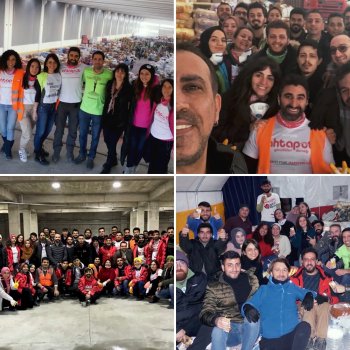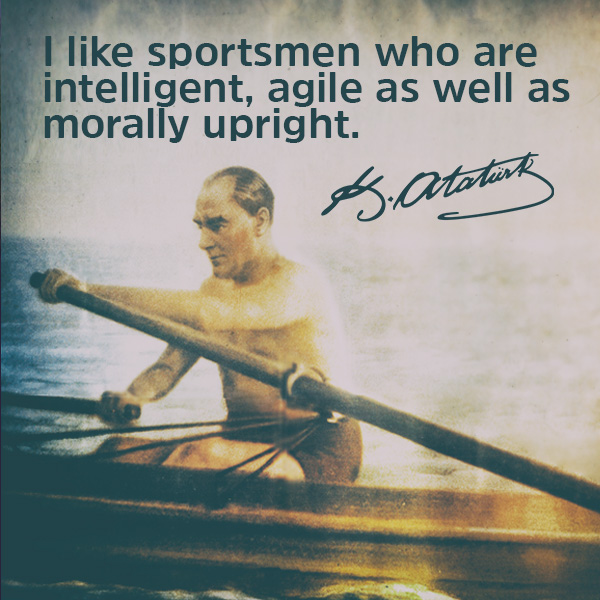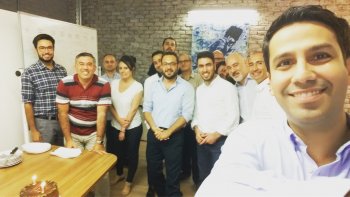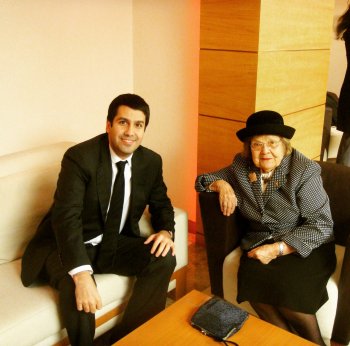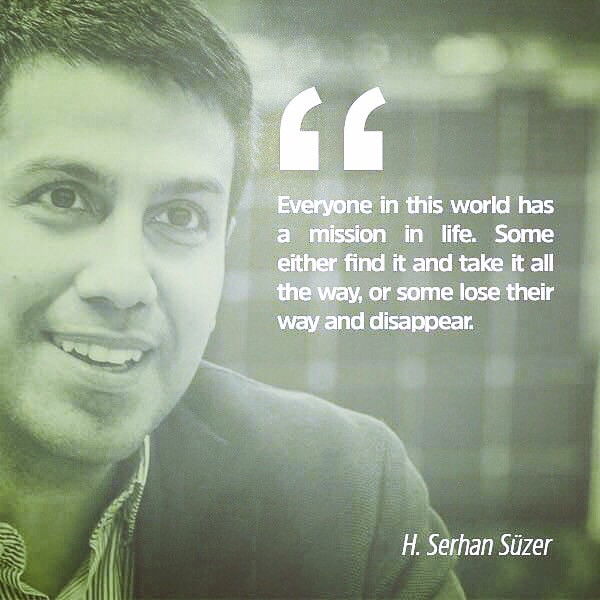Solar energy solutions from the facade to the roof
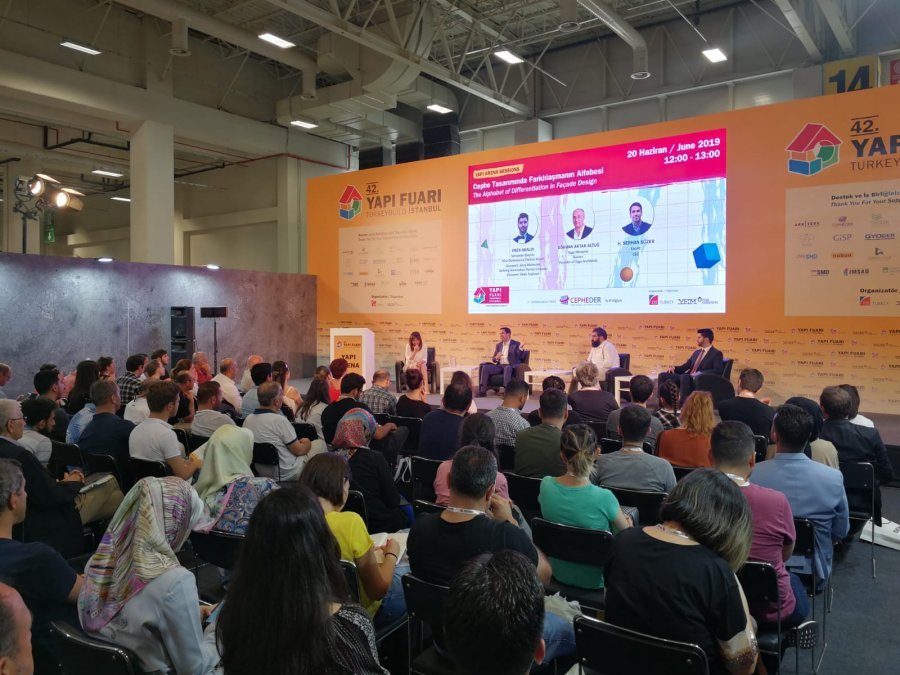
I attended the conference held at TÜYAP last week for professionals of companies producing roof and facade profiles with a presentation I prepared on the call from CEPHEDER to share information on solar energy technologies. I would also like to share these up-to-date solutions that concern the future of the world and the energy independence of our country.
I met Miss Cuheyda from Arkitera which is an institution in the field of architecture, whom this time appeared before me representing firms that sell facades and roof elements, as the general secretary of a non-governmental organization CEPHEDER.
With her usual sympathetic and positive approach, she said “Mr Serhan, we would like to see you talking to the bosses and professionals of companies that sell roof and facade profiles, which I represent this time. There is a lot to tell the people in the sector about solar energy” which is when I said, “Hay hay (of course) Miss Cüheyda, I would like to help”, both as someone who has adopted the goal of ensuring that all people have access to solar energy and also because we have done successful work with her in the past. We had several more meetings after this first one. Afterwards, the date of the postponed Fair was announced, we were invited and finally took part in the event, where you can see the brochure below.
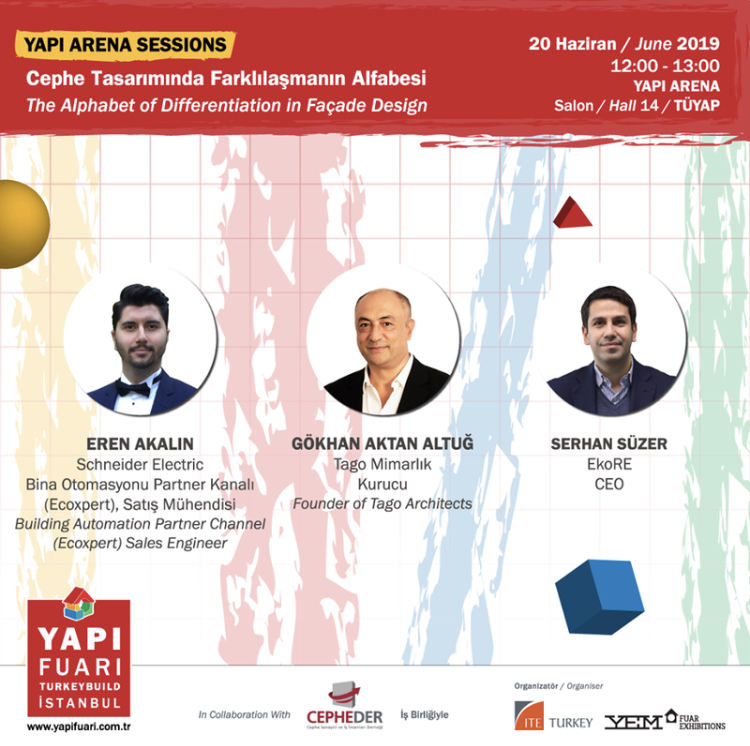
A summary of the conversations in the panel I was invited to was previously given to the potential listeners. According to this;
Schneider: With the current trends in the world, the internet of things (IoT) and the importance of building devices communicating with each other, Schneider Electric will speak of how they have elevated the energy efficiency and comfort of the buildings by using building automation technologies.
TAGO Architecture: It will be “the forefront as a communication tool". The phenomenon we want to address is the ability of the facade to express itself from the past. Is it a concept that can be gained by design or is it a result of the function? Here, we want to try to define the relations of the buildings with people and each other starting from the traditional and cultural themes, while doing so, we will touch on the architectural roles of the facade and the new areas of use in visual communication. We will also touch on what different approaches should be addressed in the city and on a pedestrian scale.
My speech: Today's rapidly increasing demand for energy is pushing people to find more and different sources of energy. Unfortunately, the world is relying on fossil fuels to meet this intense energy demand. However, in order for humanity to have a future, it becomes very important to meet this increasing demand with renewable energy sources. Solar energy is the most promising when it comes to rapidly increasing efficiency, reduced costs, ease of construction and operation among renewable energy sources. In this context, the biggest aim of EkoRE is to create a livaeble and sustainable future by establishing the panel factory, which will be produced 100% locally in our country, and by following the ever-developing technologies, by ending humanity's dependence on fossil fuels. Although solar energy technologies have many different application areas, the subject of this presentation is the facade applications of lesser known solar energy. Focusing on how different technologies are used in different facade applications will focus on how these systems meet the energy needs of buildings.
The journey begins…
Assuming that it would take 2 hours from Çekmeköy to Beylikdüzü, we left the office at 9.45am for the event to start at 12pm. Traffic was clear as the repair and maintenance works on the second bridge hadn’t started yet. We reached Beylikdüzü in 1.5 hours. It took us about half an hour to reach the conference venue from there. TÜYAP is a big fair area and our driver left us at one end of the fair, and the conference area was on the other end of the fair area.
I had pain in my heel, and I walked that road for about 15-20 minutes. When I arrived at the site, I immediately handed over my presentation papers. I met with the organizer company officials and Miss Cüheyda. I met the other speakers. After the microphone and other equipment was installed, we were ready to speak. After a 10-minute delay, panelists were invited. When I got on the platform, I shook the hand of our moderator and the speakers and sat down.
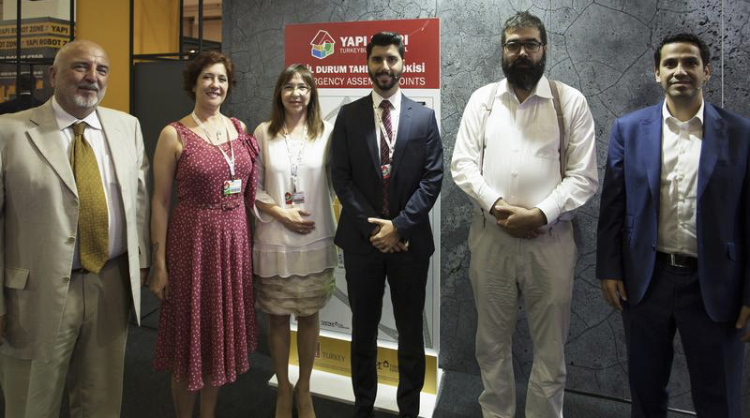
The photo we took together just before the panel. From left to right: Adil Baştanoğlu, Cüheyda Başık, head of Cepheder and Ciftder, our moderator, Eren Akalin, one of the speakers, architect Emre Kurbak and me.
Keeping the pulse up of the audience
They gave Mr Eren Akalın, from Schneider Elektric, who is building automation partner channel sales engineer, the first chance to speak. I think it touched on very important topics, I liked the content, but the presentation was a little too technical and spoke in a routine rhythm. So in the 150-person seating arrangement (I know this from the technical document that the organizer sent to us before the speech), the hall, which was about 80% full (I can say this simply by looking into the crowd, these numbers are correct or thereabouts) slowly started to empty. Mr Emre Kurbak made the second speech instead of Mr Gökhan Aktan Altuğ from Tago Architecture. The hall was 60% full when he started talking. Im not going to lie, in these situations, it makes you feel uneasy. If the second speaker made such a technical and uniform speech, more than half of the hall might have been emptied when it came to me.
However, architect Mr Emre Kurbak made a full remarkable speech. Participants were watching him with excitement, especially when he provided substantial examples from everyday life and buildings, which made people listen to him with full attention. The hall started to fill up again. When he finished speaking, the hall had reached 80% occupancy. Now, it was my turn. Since I had to complete my speech in 20 minutes, I quickly passed the parts of the presentation about our company and did not show our video. Then I explained different technologies and models in solar energy with a similar method to the previous speaker, showing examples from the projects that were made. The hall was filled to the brim, and even in the second half of my 10 minutes of speech, they started bringing additional chairs in for those who were standing. With the additional chairs they brought in, the hall became 110% full.

You can see the location of the stage in the technical document sent to us by the organizers.
I would like to share some of the photos taken from my presentation so that you can visualise the day in your mind:
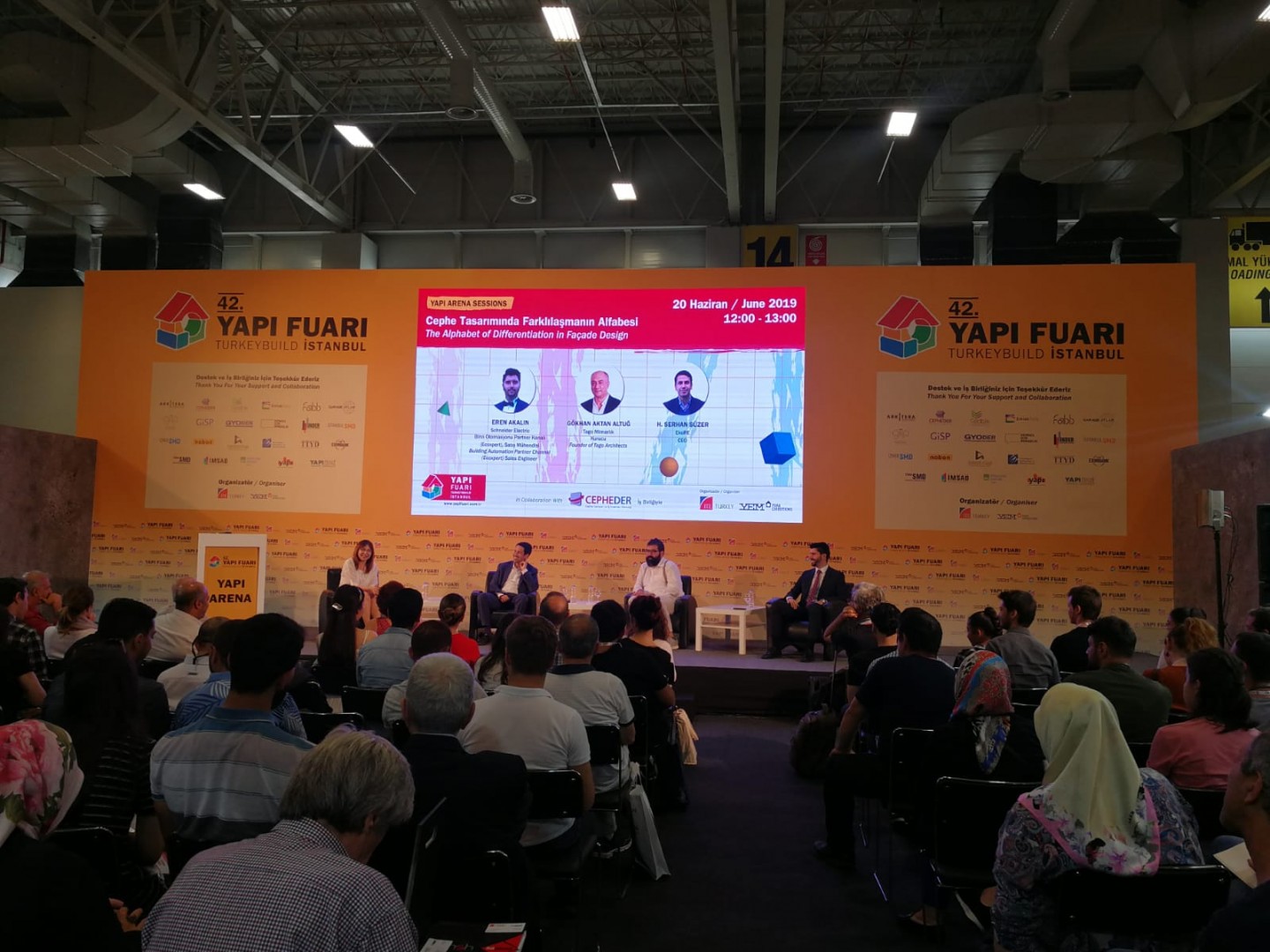
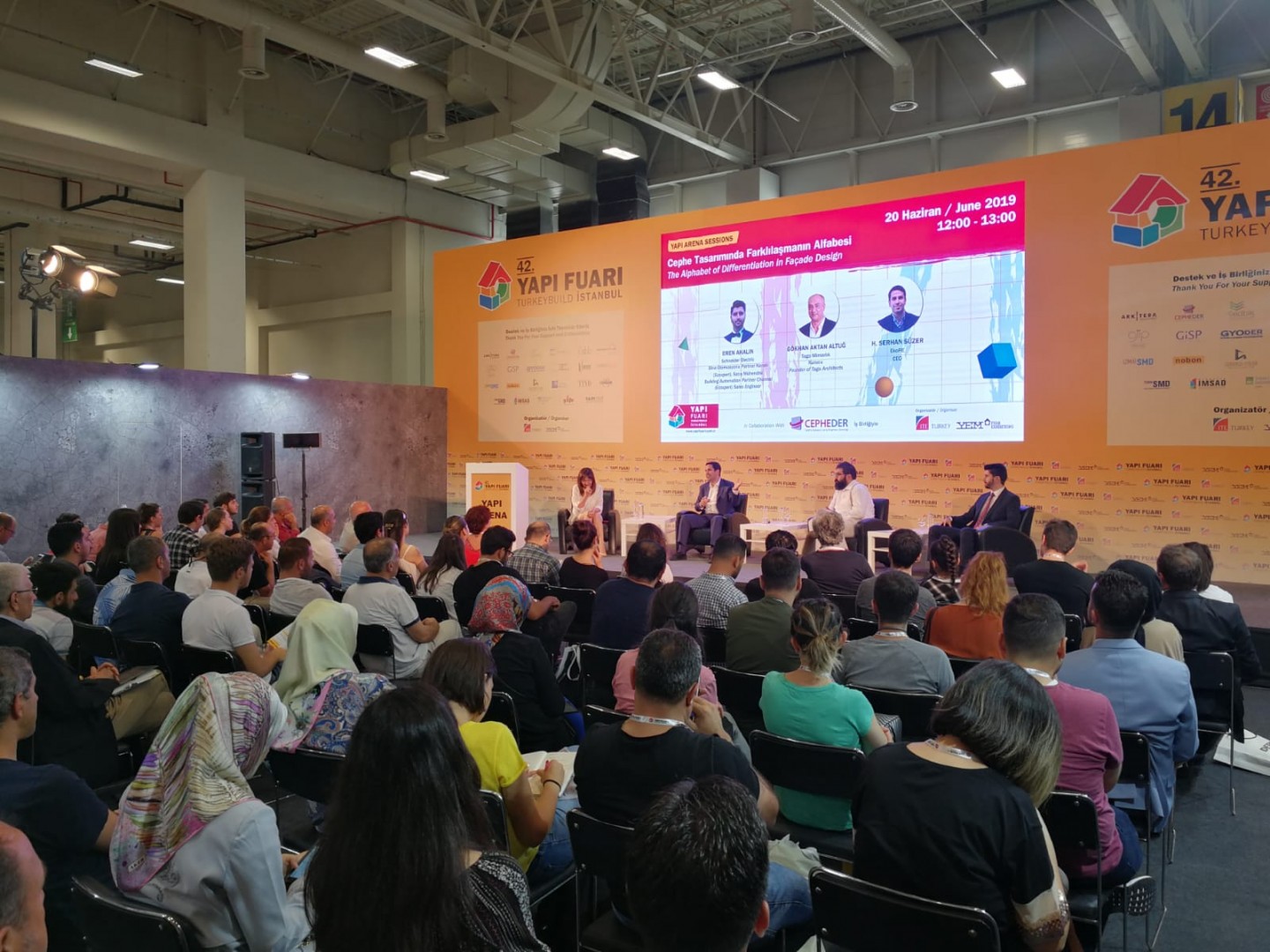
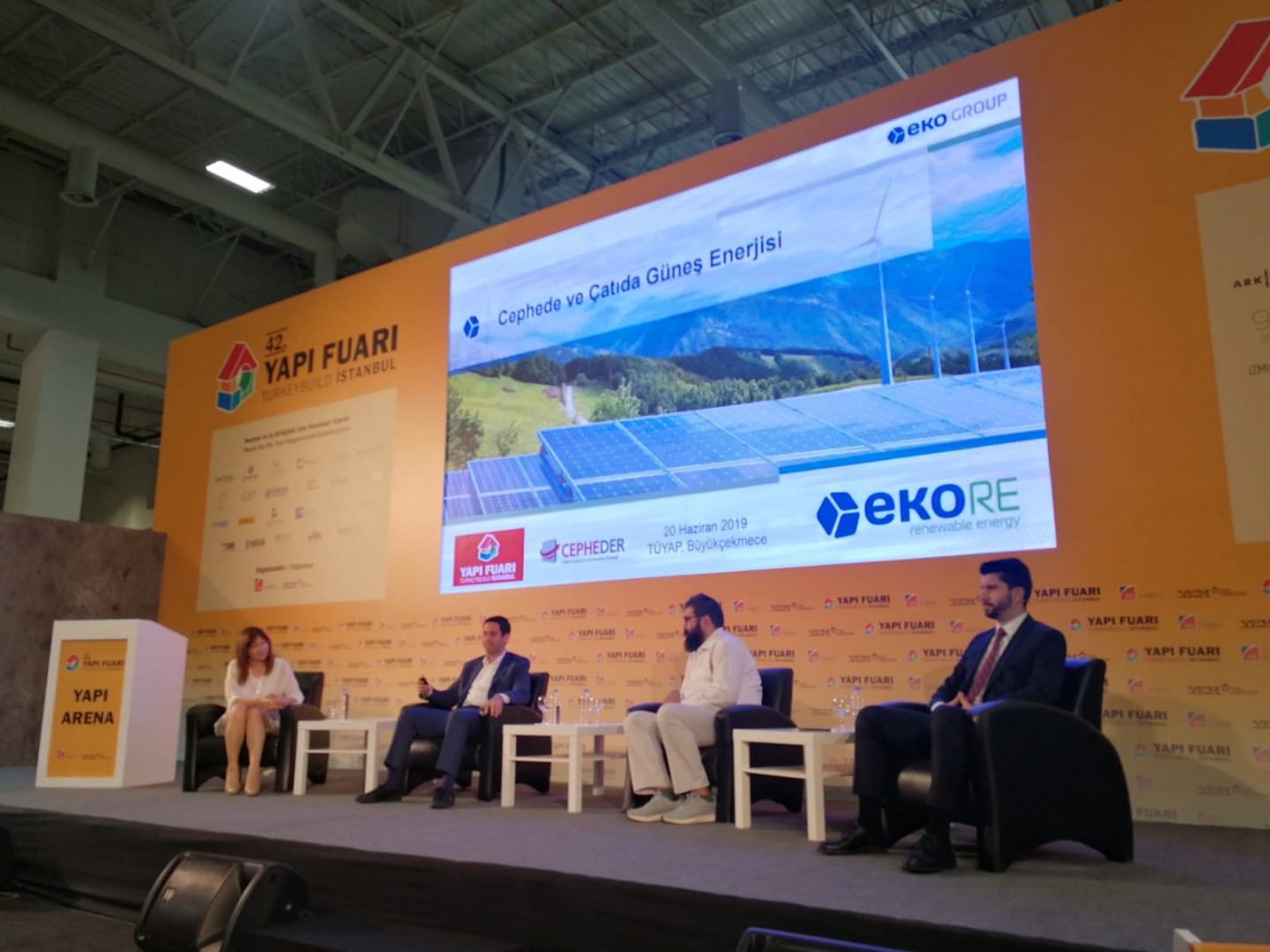
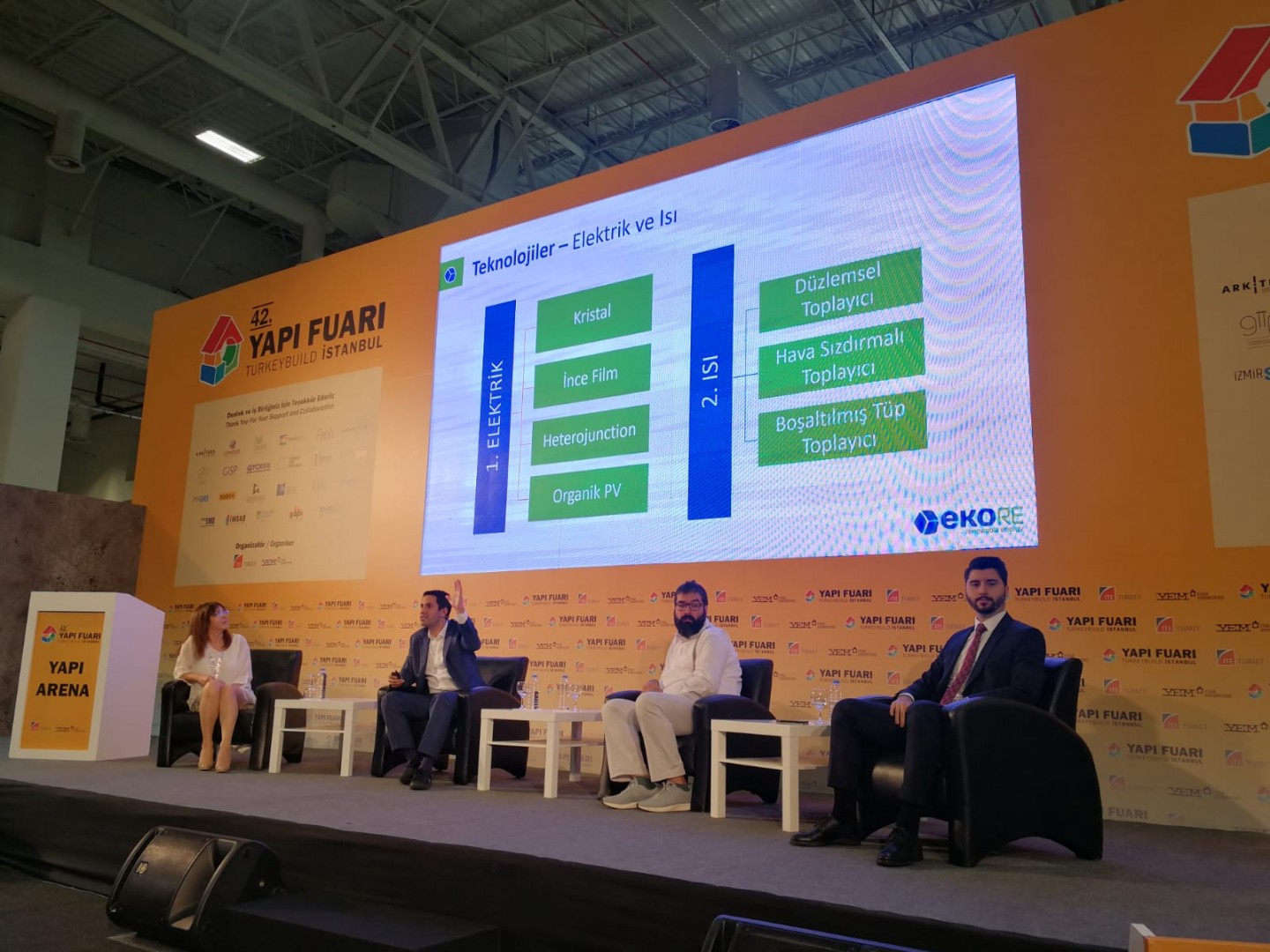
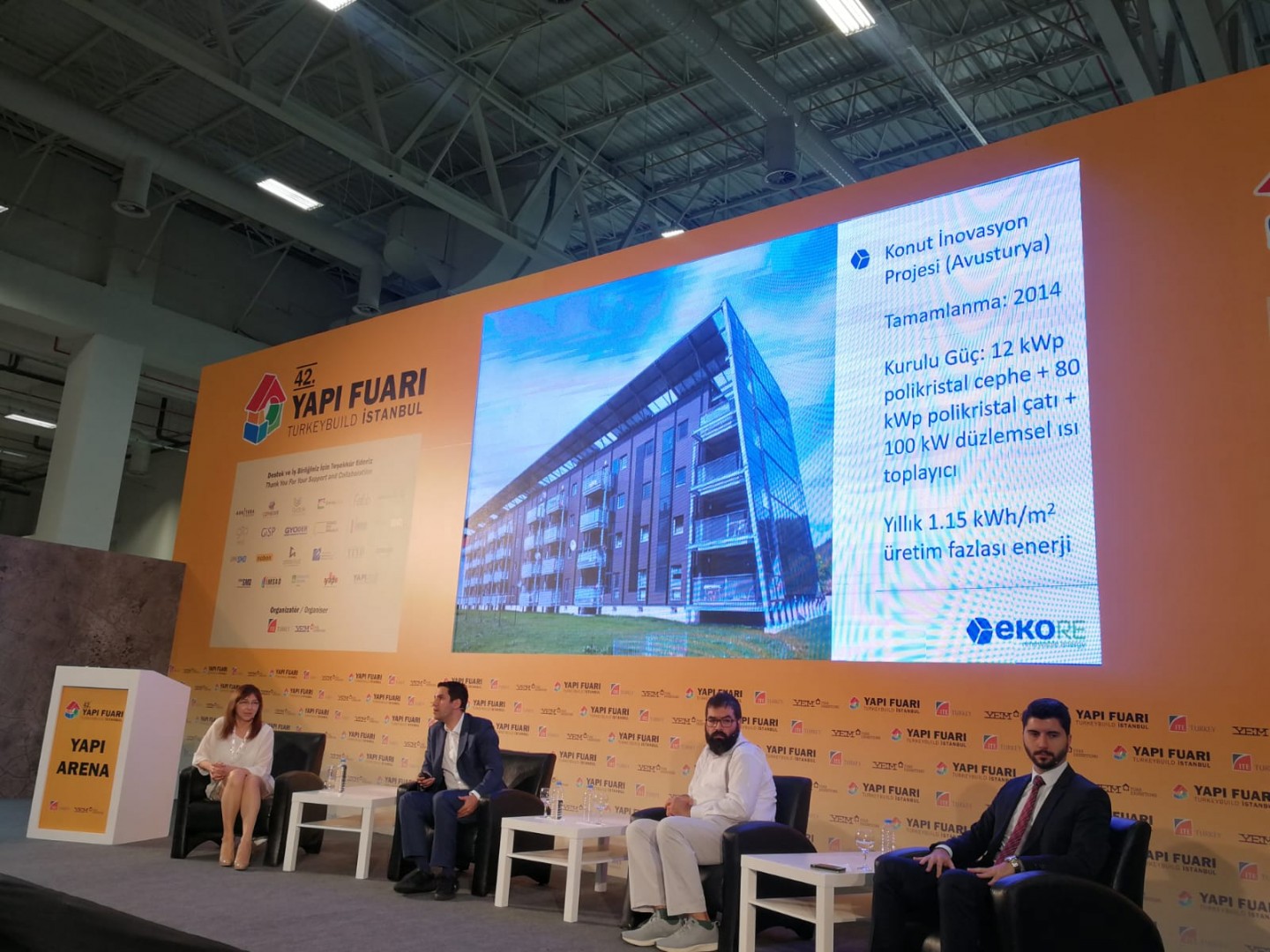
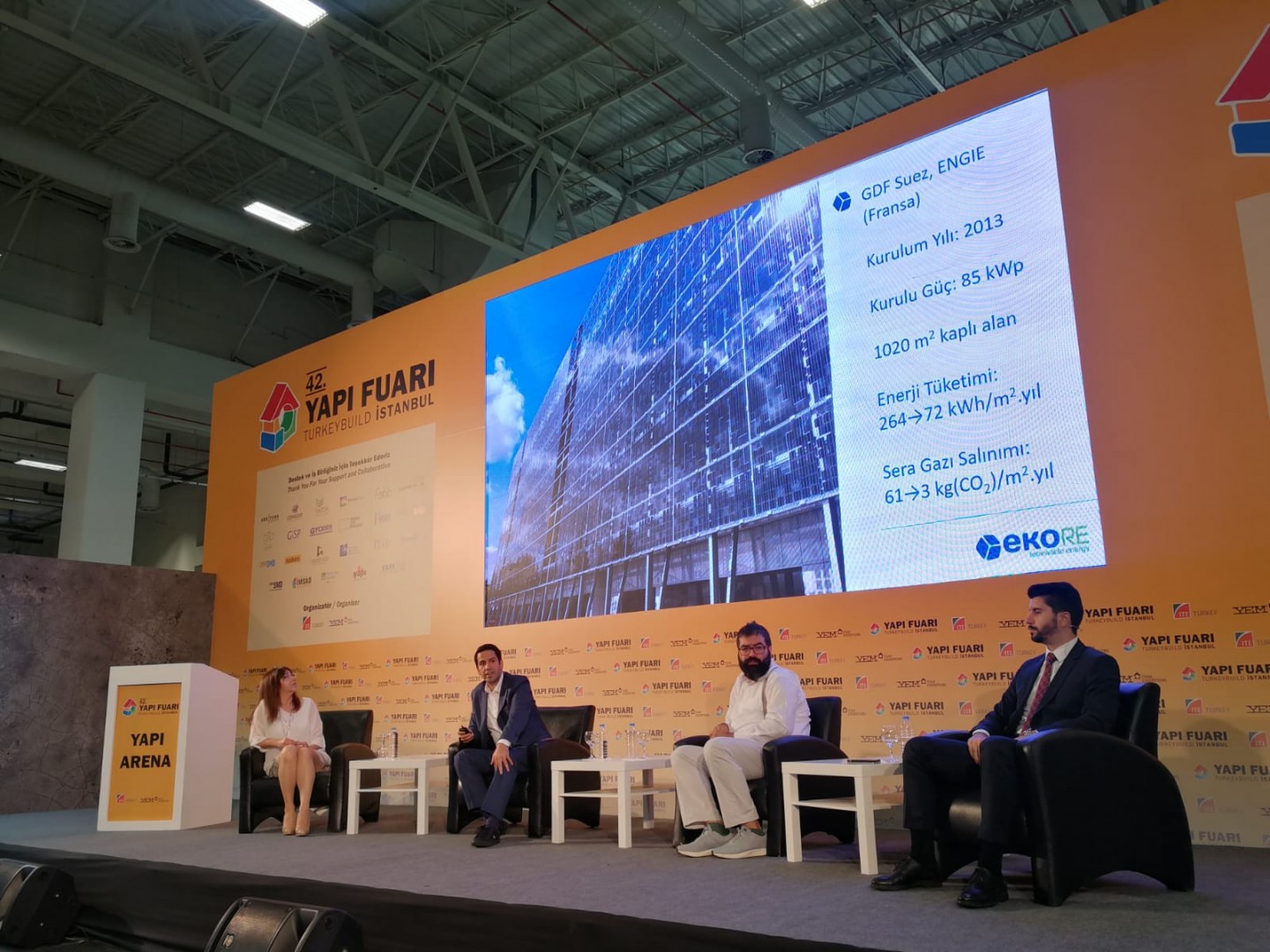
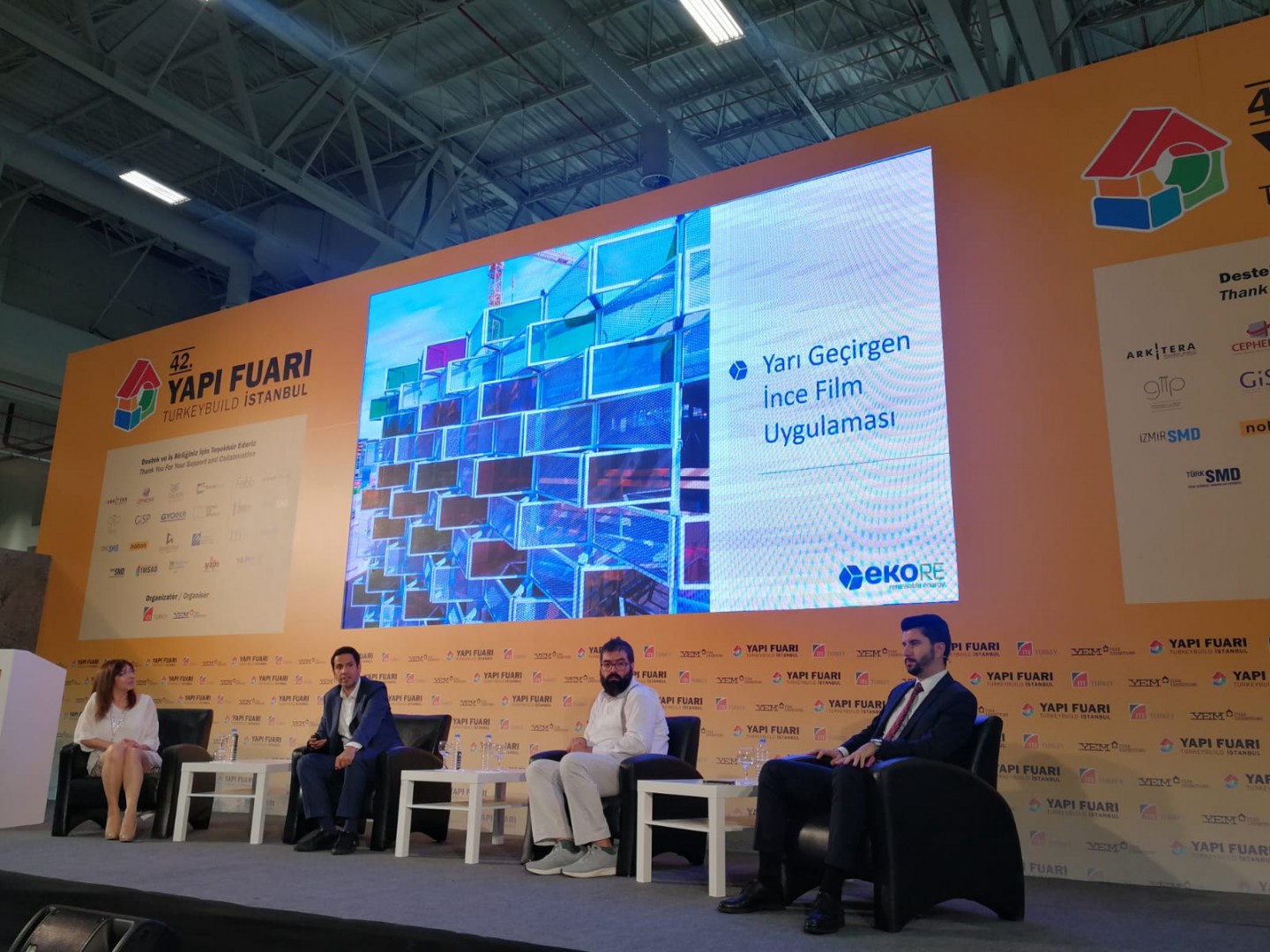
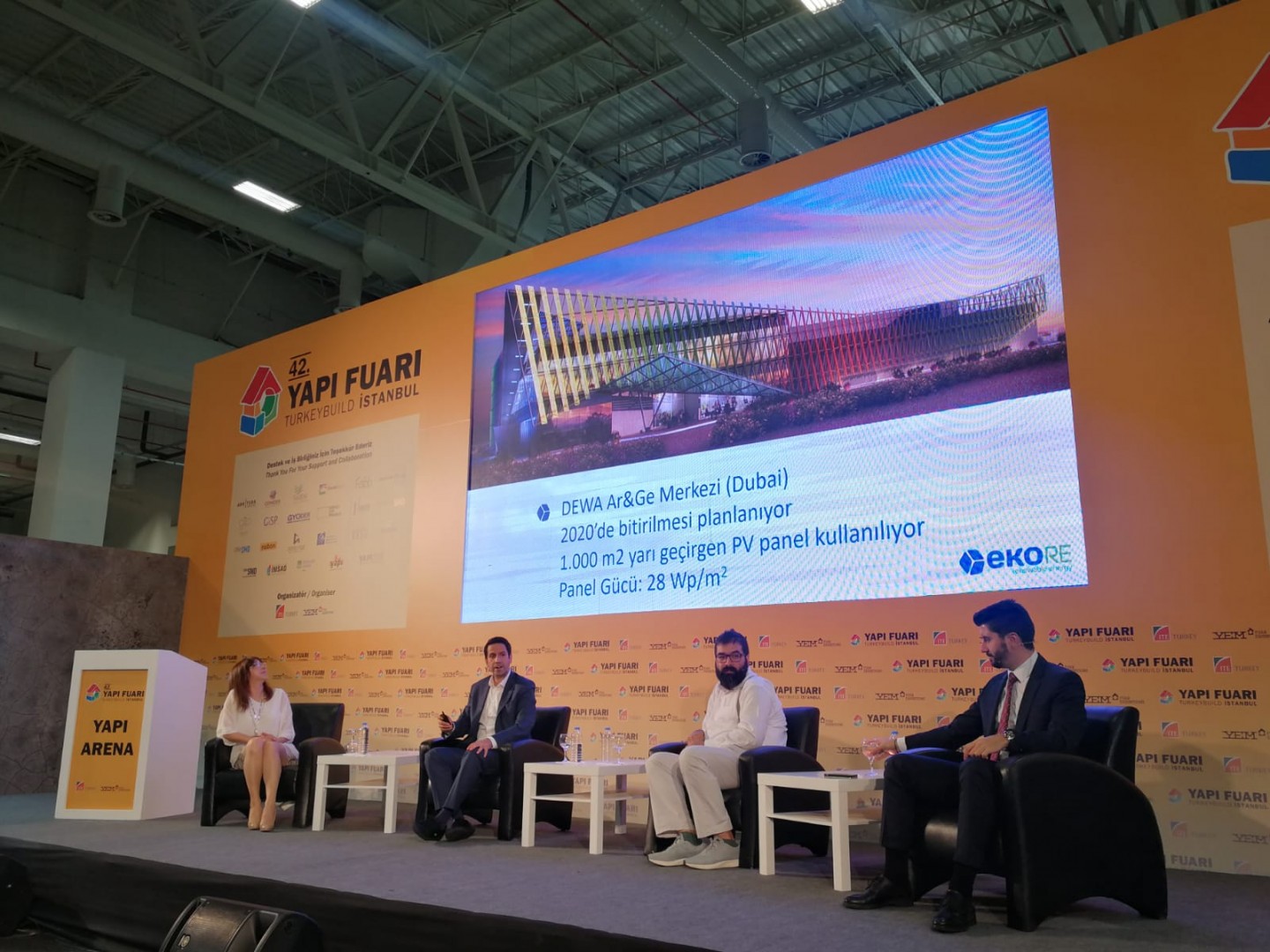
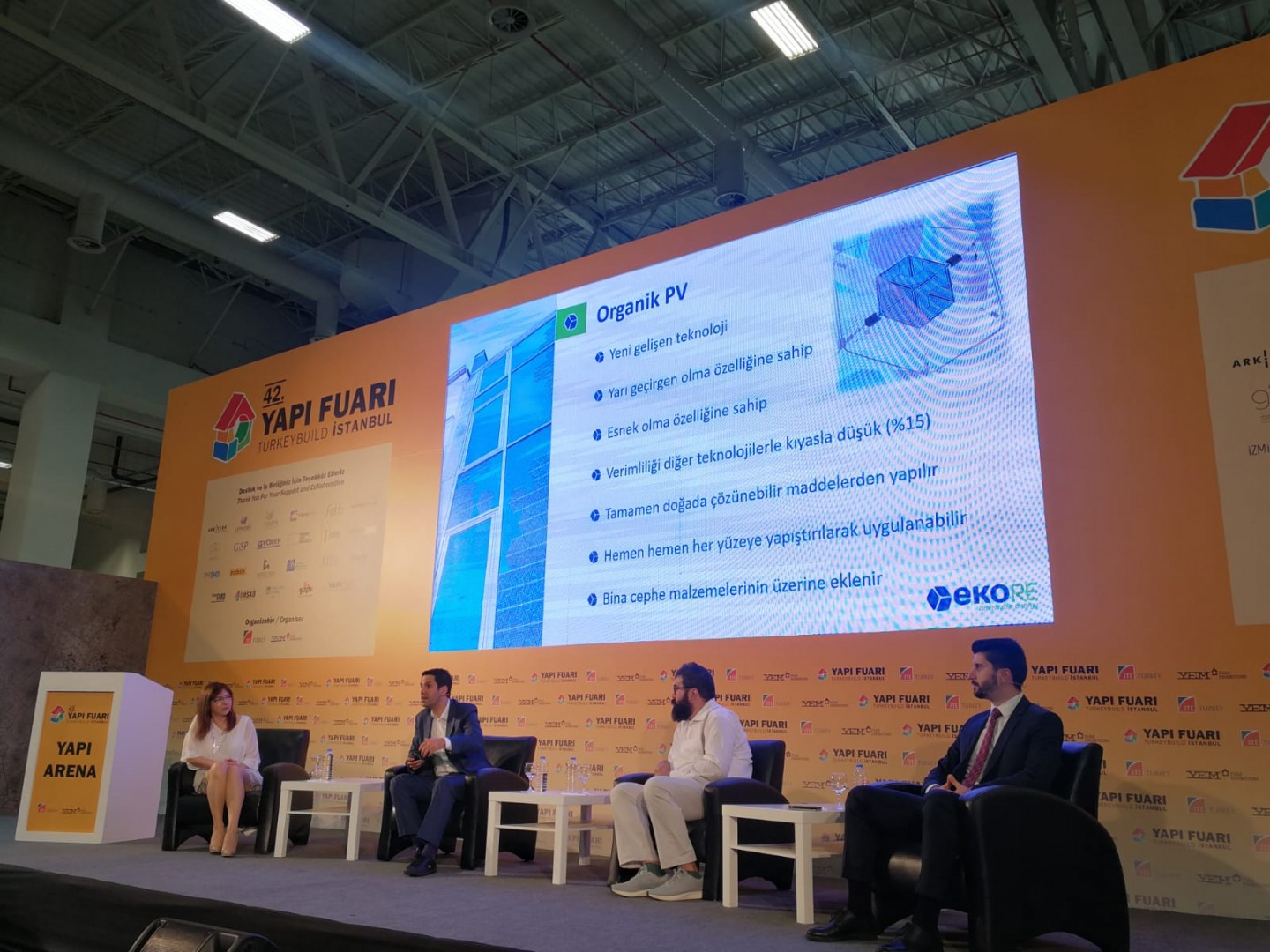
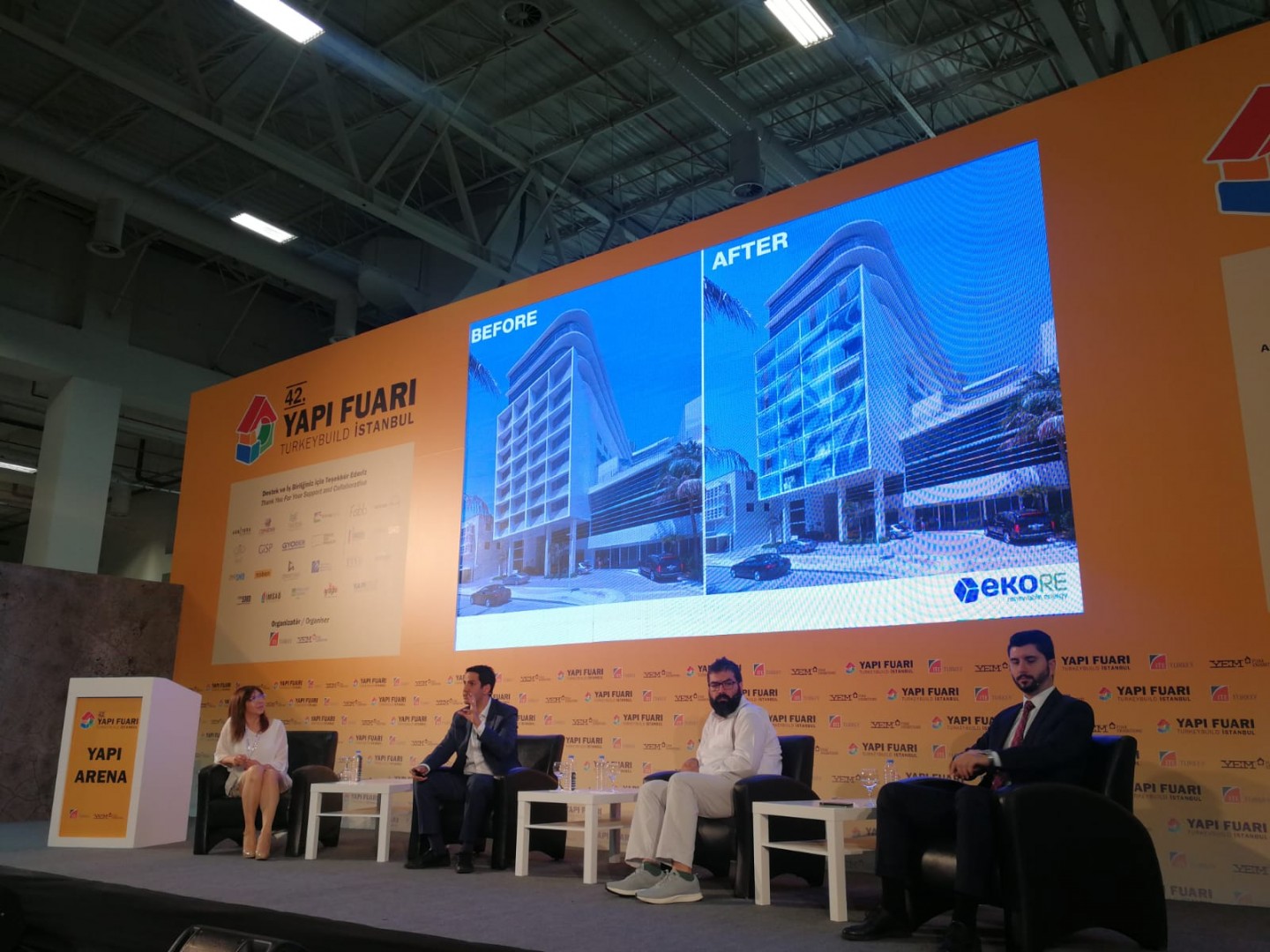
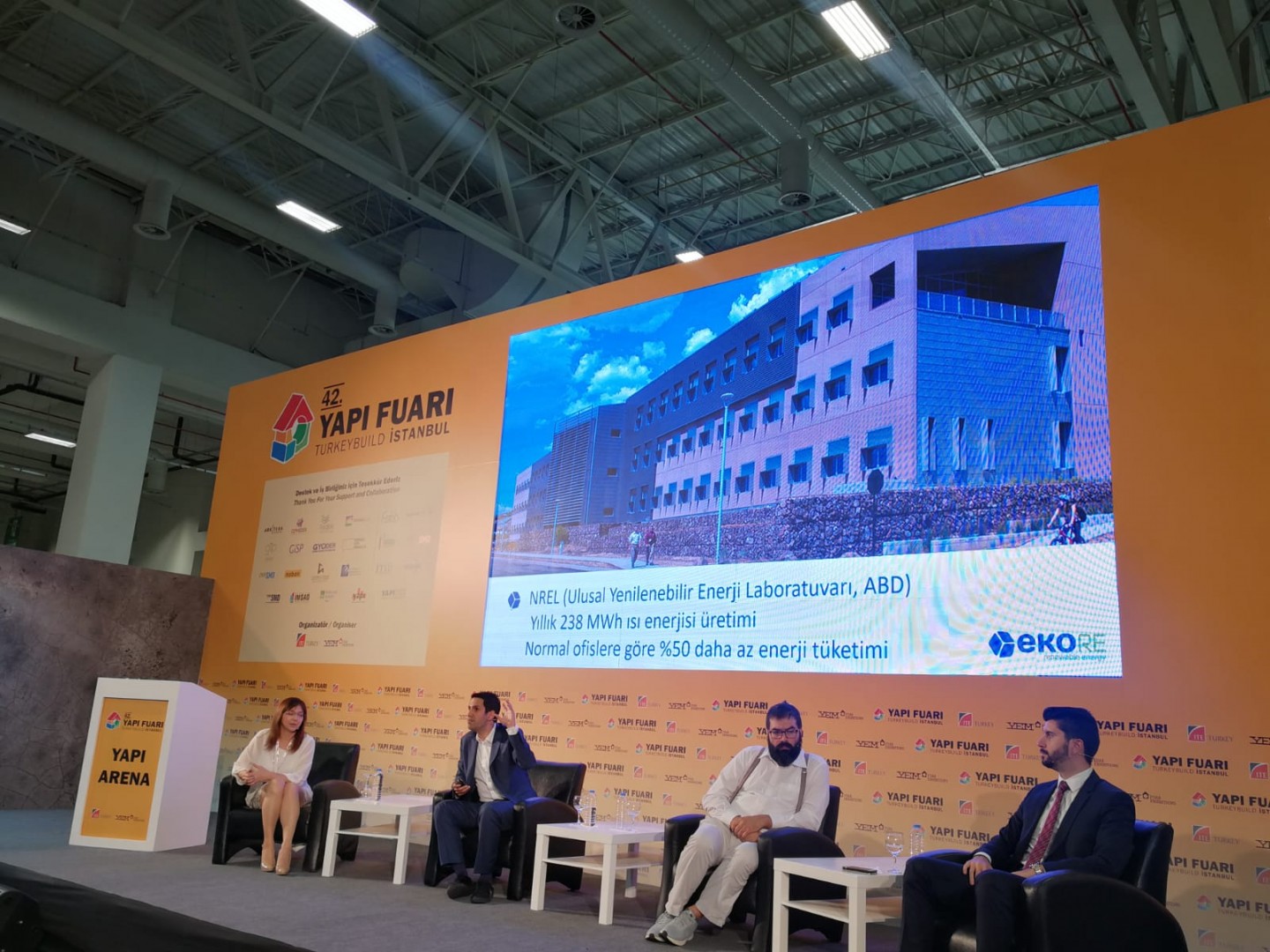
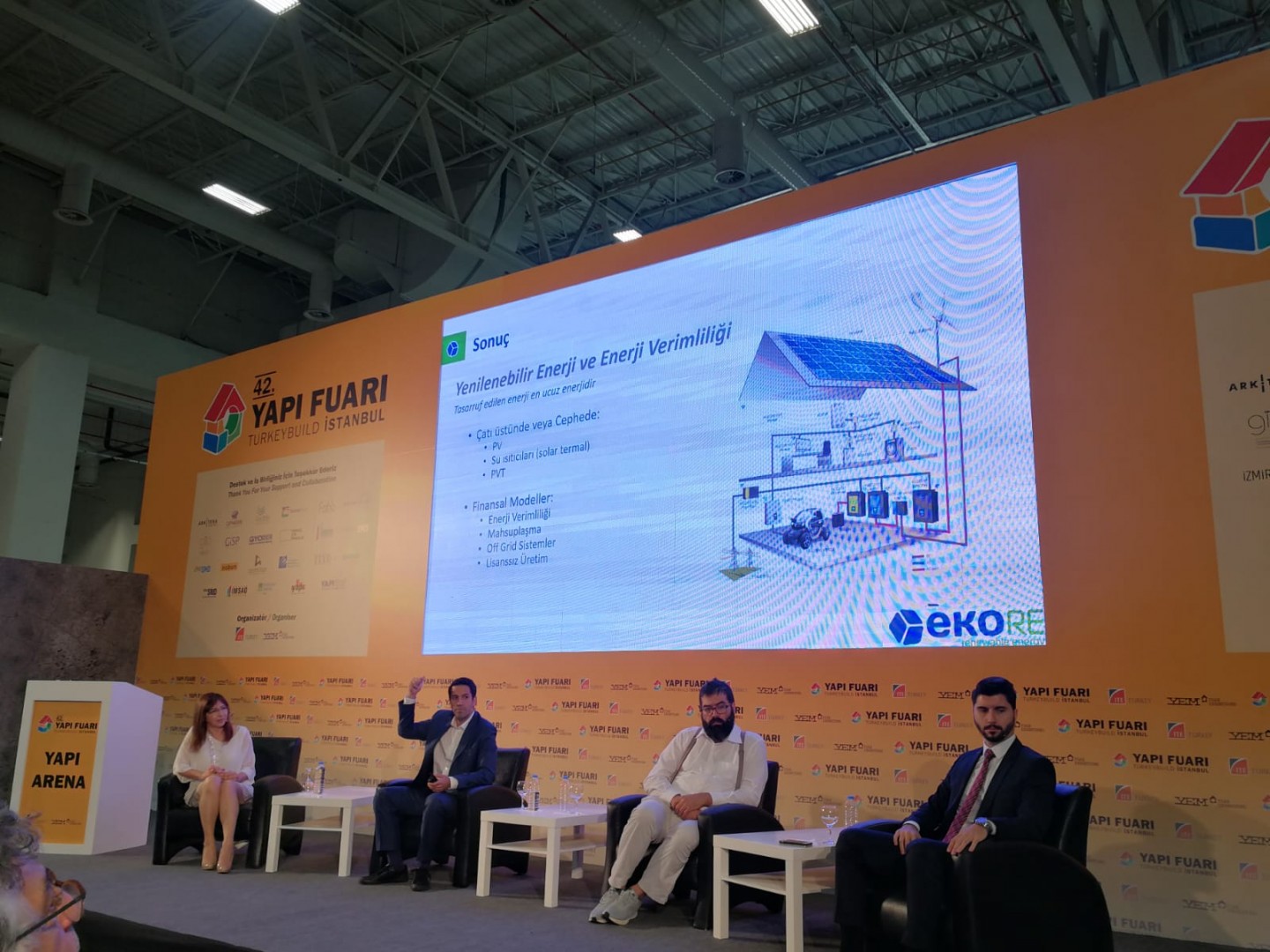
My presentation and updated notes
I would like to share my presentation with you as I think it will also make a contribution to my readers:
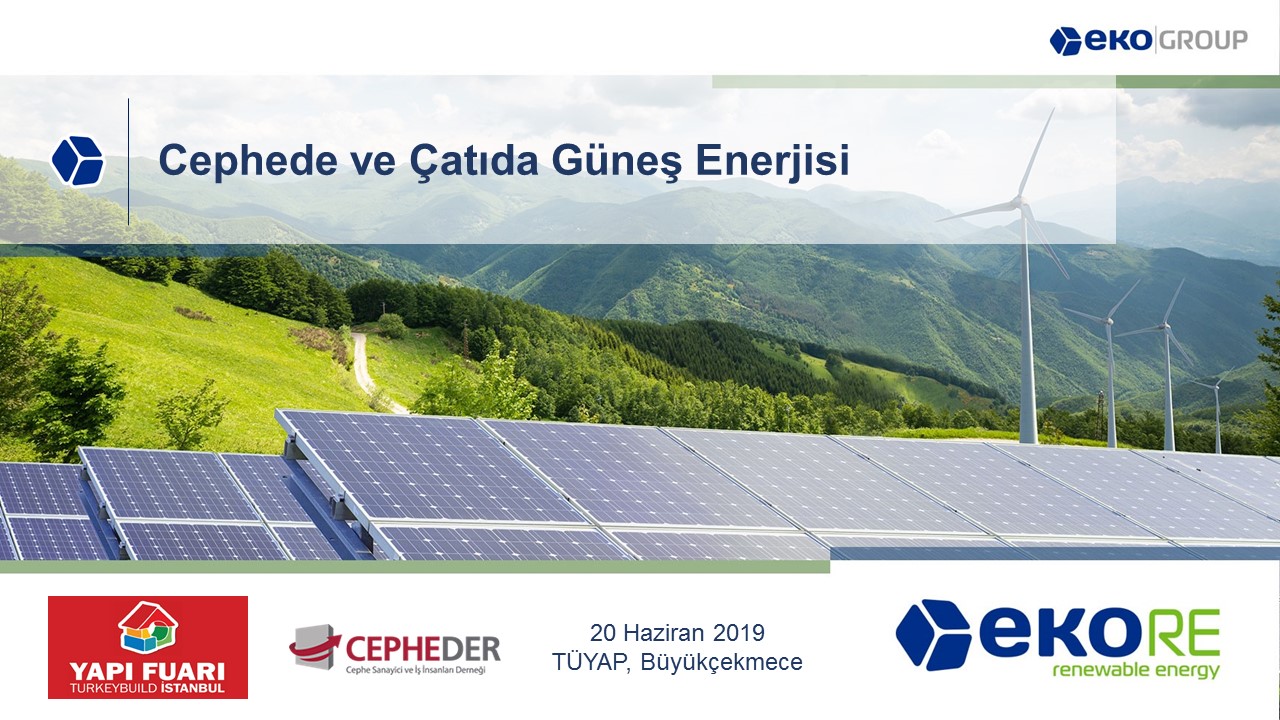
After the aesthetic appearance focusing on architectural presentation on the front, I mentioned that I will emphasize the function and different technologies in this presentation.
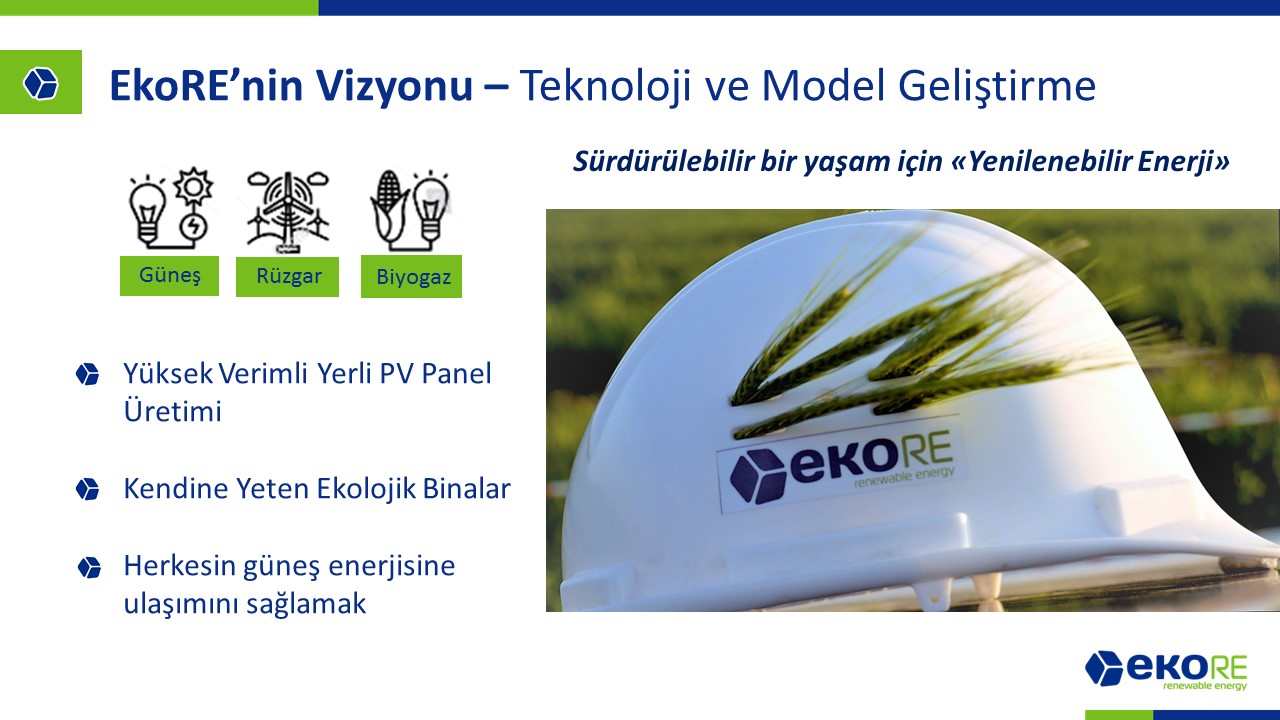
Energy production is evolving into a more modular structure. As a result, it is aimed to consume the energy produced on site. Problem; the warming of the Turkish people to solar technologies and dollar-based prices. The purpose of EkoRe is to produce the whole process with highly efficient PV panels (up to the removal of the mines) and to eliminate the pressure on dollar-indexed prices, producing in Turkia and to offer products to consumers at a much affordable price. As a company, our most important mission is to provide all people with access to solar energy.
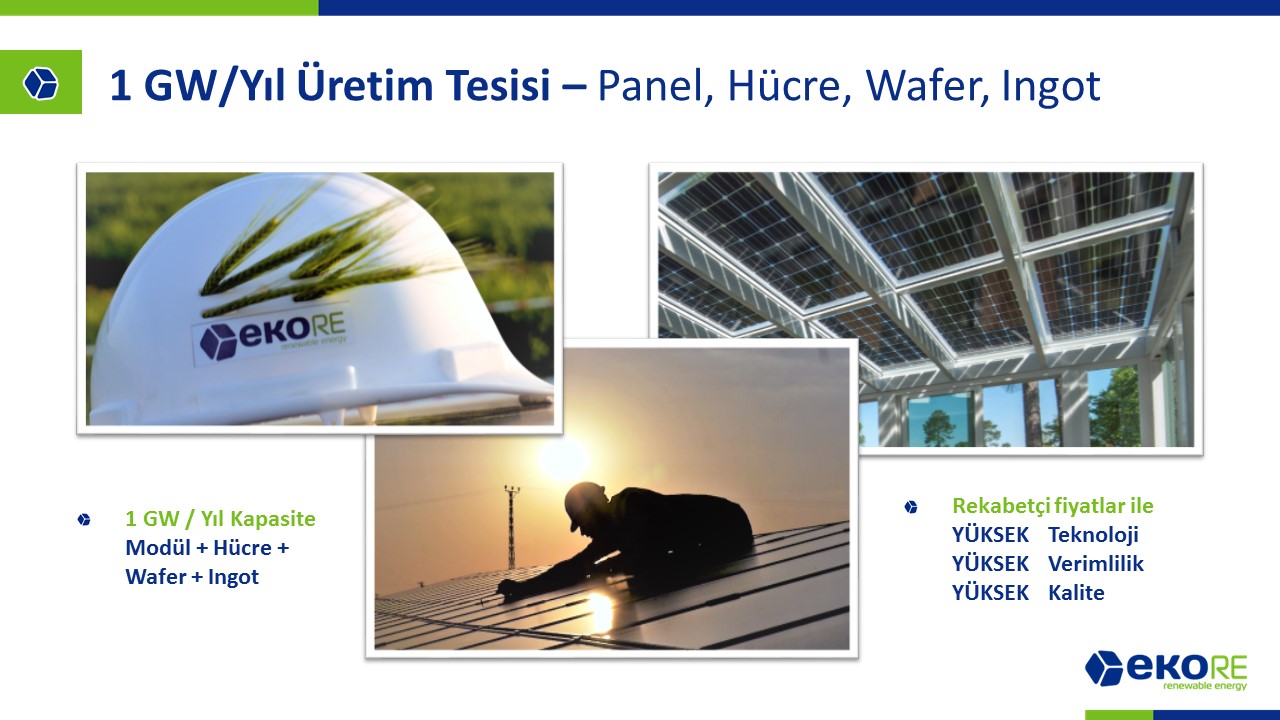 For this purpose, we held our groundbreaking ceremony in March for the production of integrated solar panels including ingot, wafer, cell and module processes.
For this purpose, we held our groundbreaking ceremony in March for the production of integrated solar panels including ingot, wafer, cell and module processes.
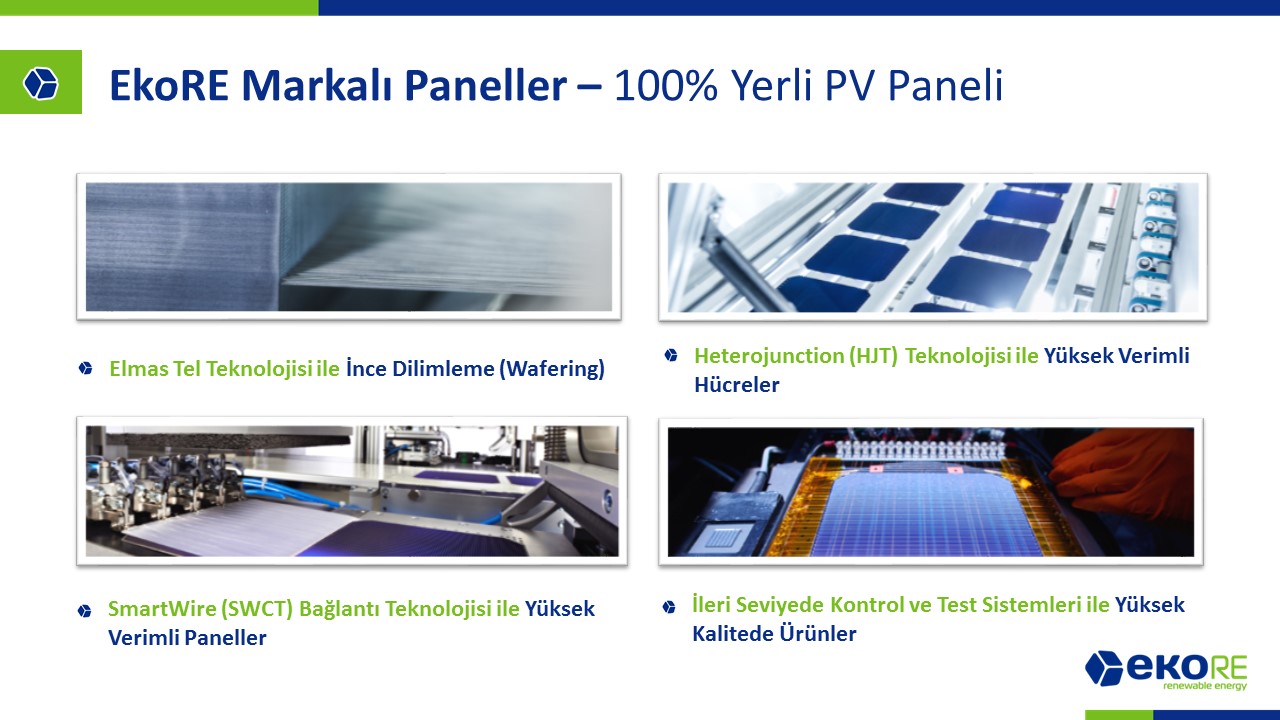
High-tech processes are preferred in heterogeneous panel production, and the efficiency of the cells will be maximized, and the ongoing R&D studies will increase the efficiency of the panels every year. Thus, maximum efficiency can be achieved in roofs and facades, which are a limited area.
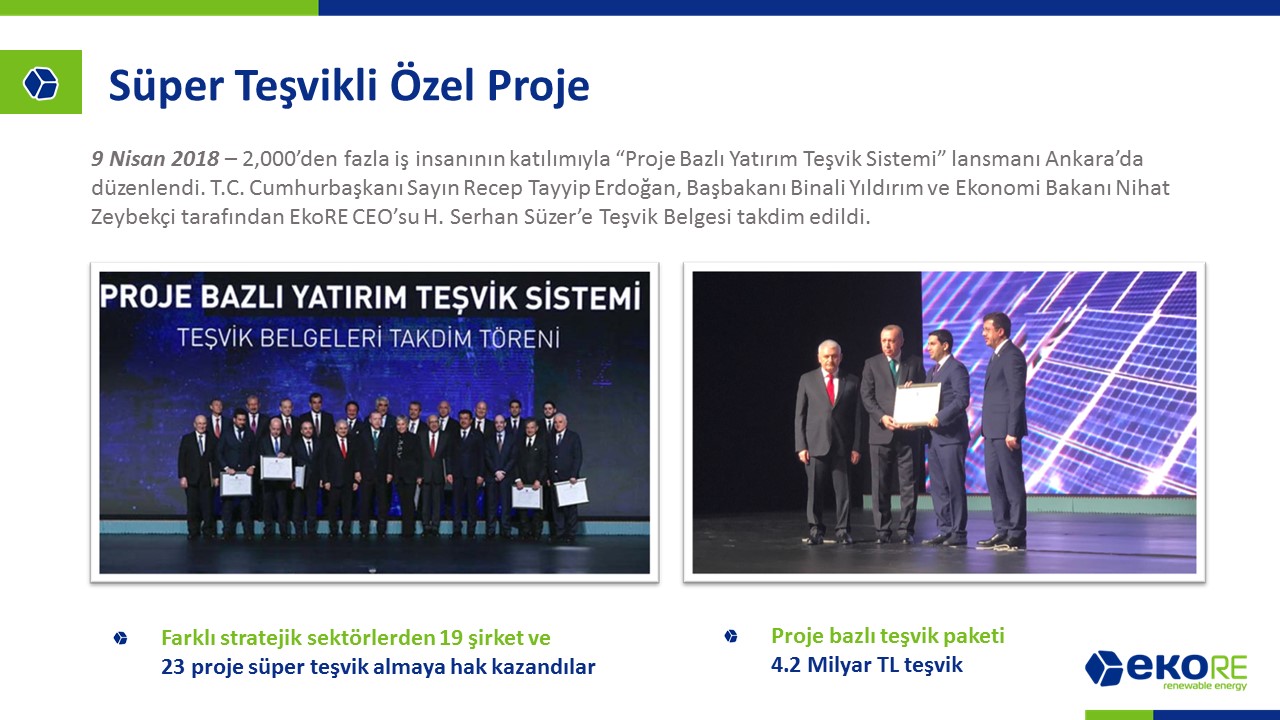 Last year, we received an incentive for our project, which is strategically important for the country. We named this visionary project, which is entitled to project-based incentives, as “100% domestic solar panel production for energy independence”.
Last year, we received an incentive for our project, which is strategically important for the country. We named this visionary project, which is entitled to project-based incentives, as “100% domestic solar panel production for energy independence”.
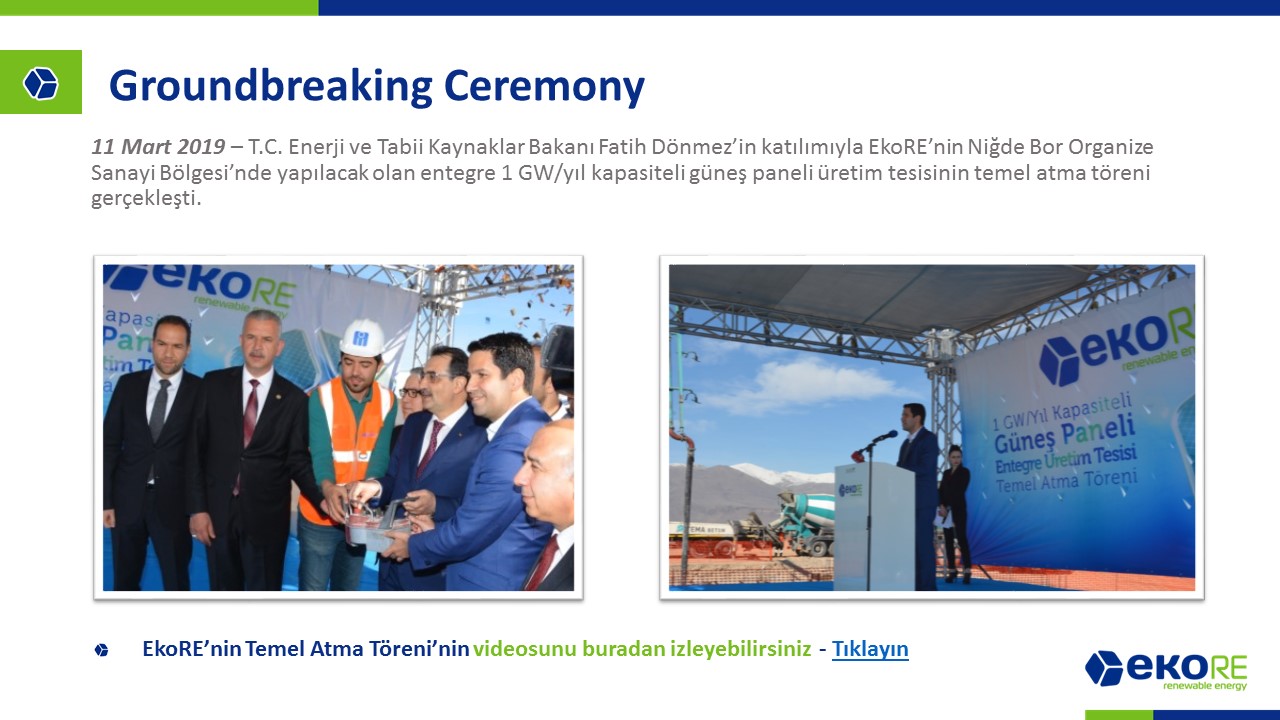
We held our groundbreaking ceremony with the participation of our Minister of Energy and Natural Resources, Mr Fatih Dönmez. Wishing good luck to our country.
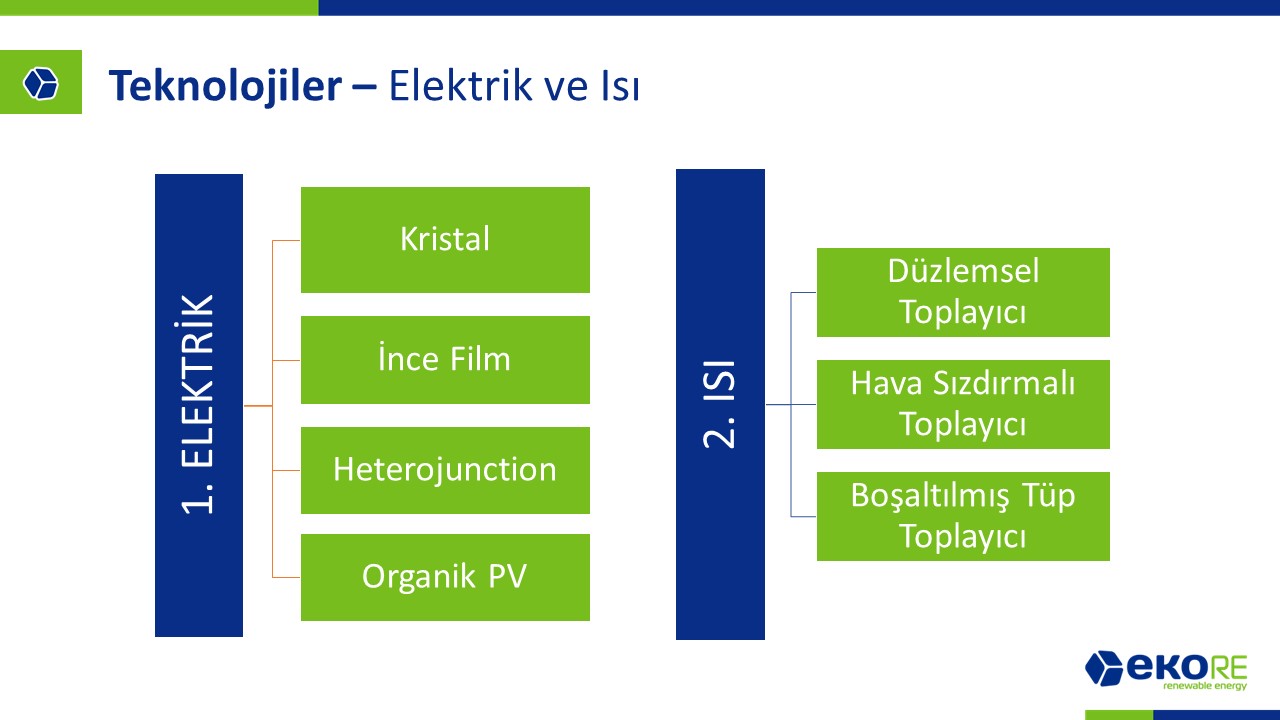 Now let's come to the core of our topic. Technologies used in the facades are divided into two. The first is electricity, and the second is heat.
Now let's come to the core of our topic. Technologies used in the facades are divided into two. The first is electricity, and the second is heat.
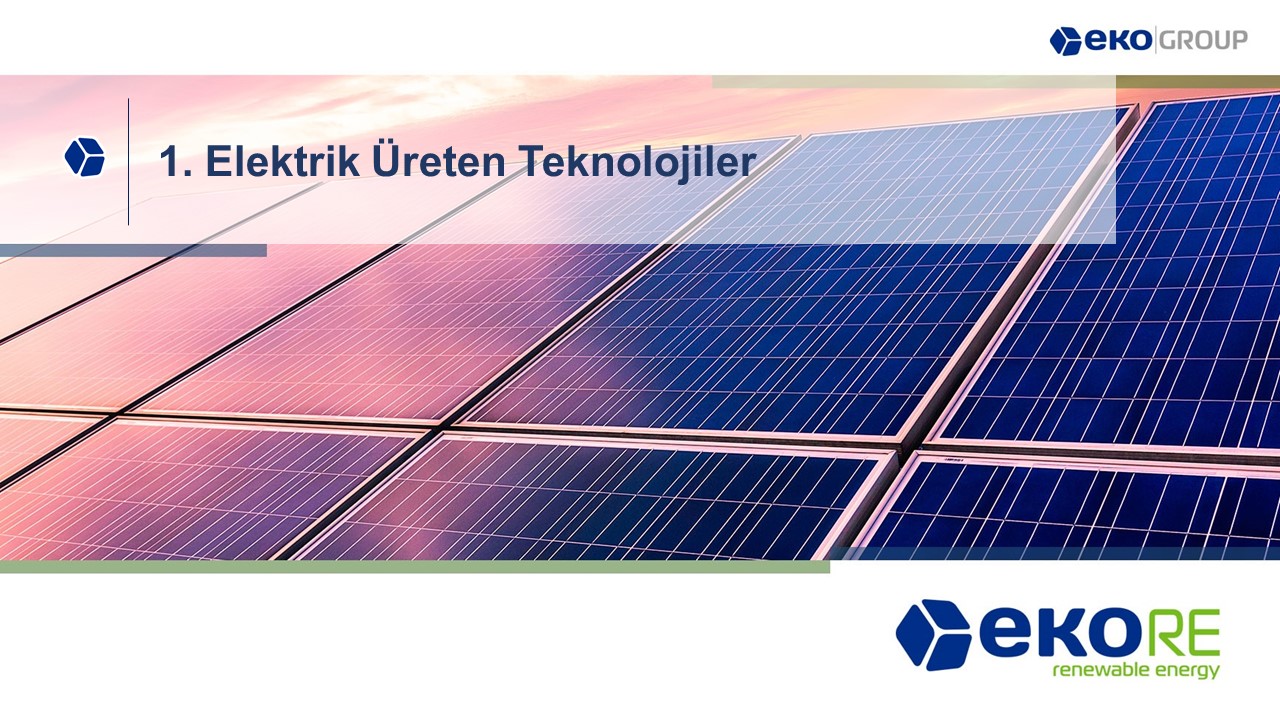
One of Turkia’s biggest problems is in the area of energy. We are highly dependent on foreign countries. But the solution to this is actually quite simple. As set in EkoRe’s vision, it is to spread all the processes and technologies regardless of residential or office area and to achieve high-efficiency panels developed in Turkia and to win our independence in energy by supporting the battery technology of these systems. In the buildings where the space on the roof are limited, the facade applications emphasized in this presentation will gain great importance.
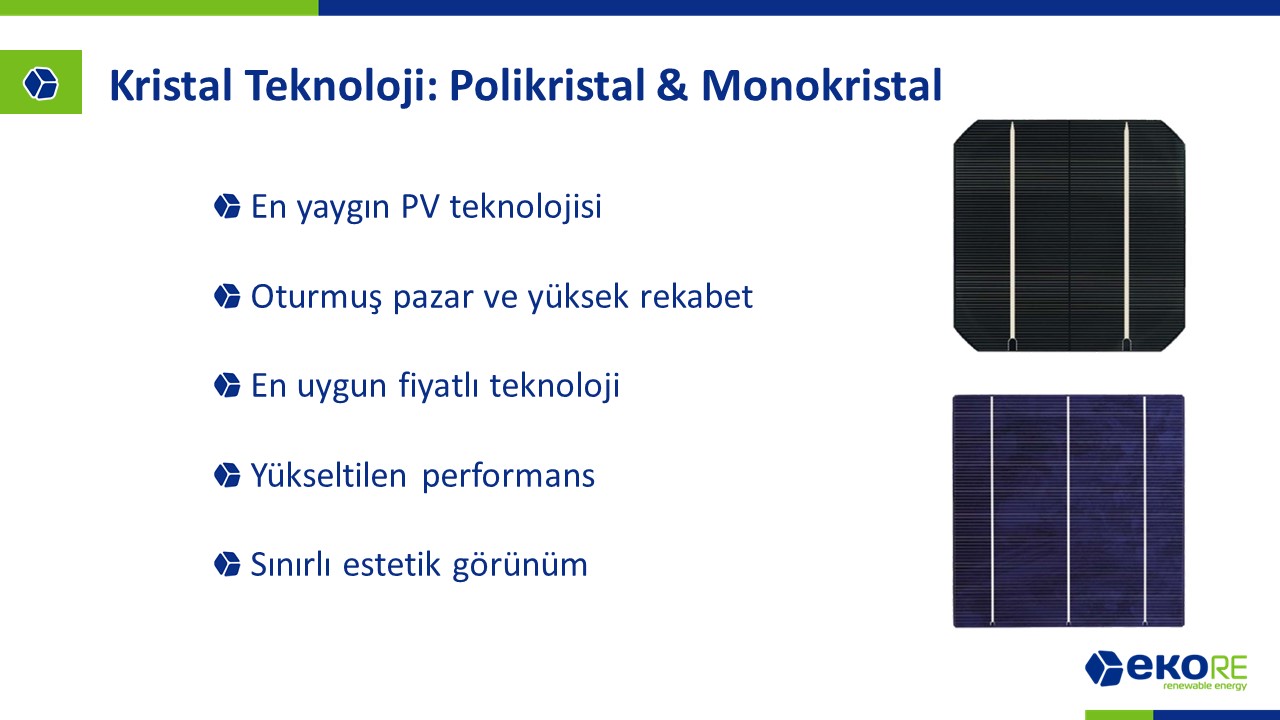 According to some, apart from the problem of the aesthetic appearance, the most preferred technology and most useful one is crystal technology. There are many application areas and its efficiency is constantly increasing.
According to some, apart from the problem of the aesthetic appearance, the most preferred technology and most useful one is crystal technology. There are many application areas and its efficiency is constantly increasing.
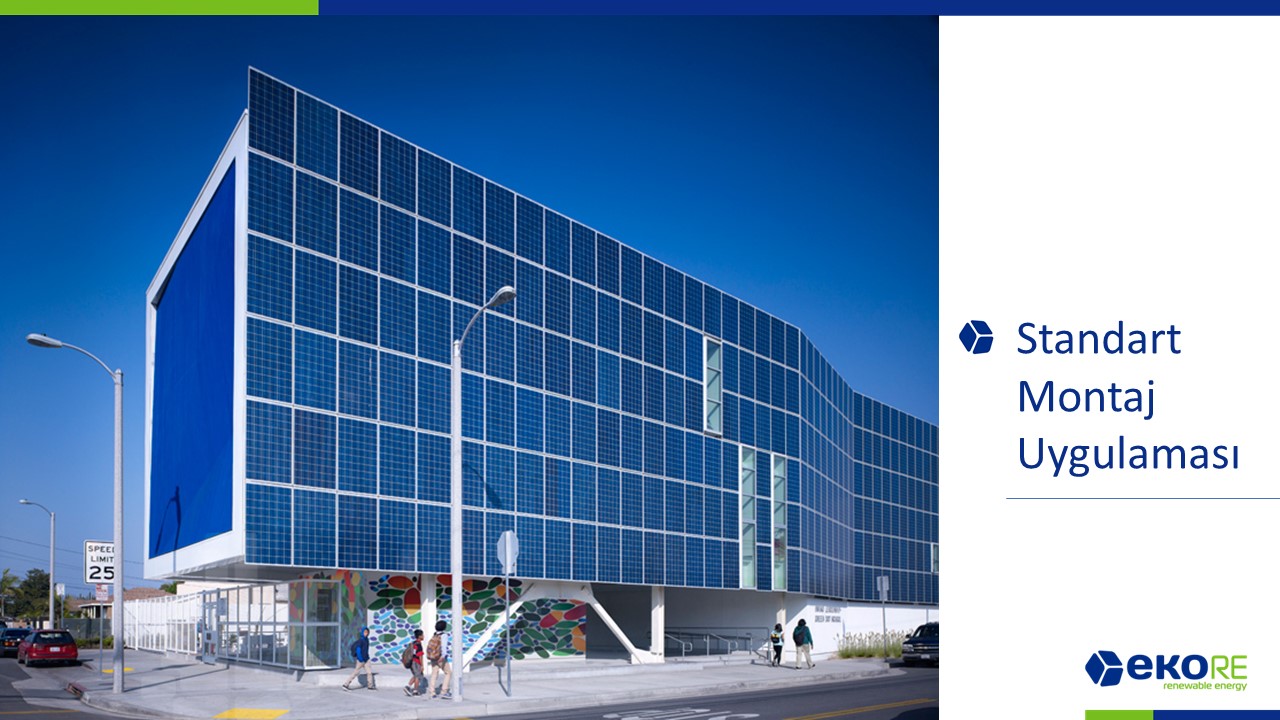
An example of crystal technology application. It is not a very preferred application because the slope of the panels is positioned at 90 degrees, not at the optimum angle (15-25 degrees). This causes a decrease in efficiency, but the important thing here is to use a surface that does not have any function for electricity generation. A good example of the potential to generate electricity without losing any space.
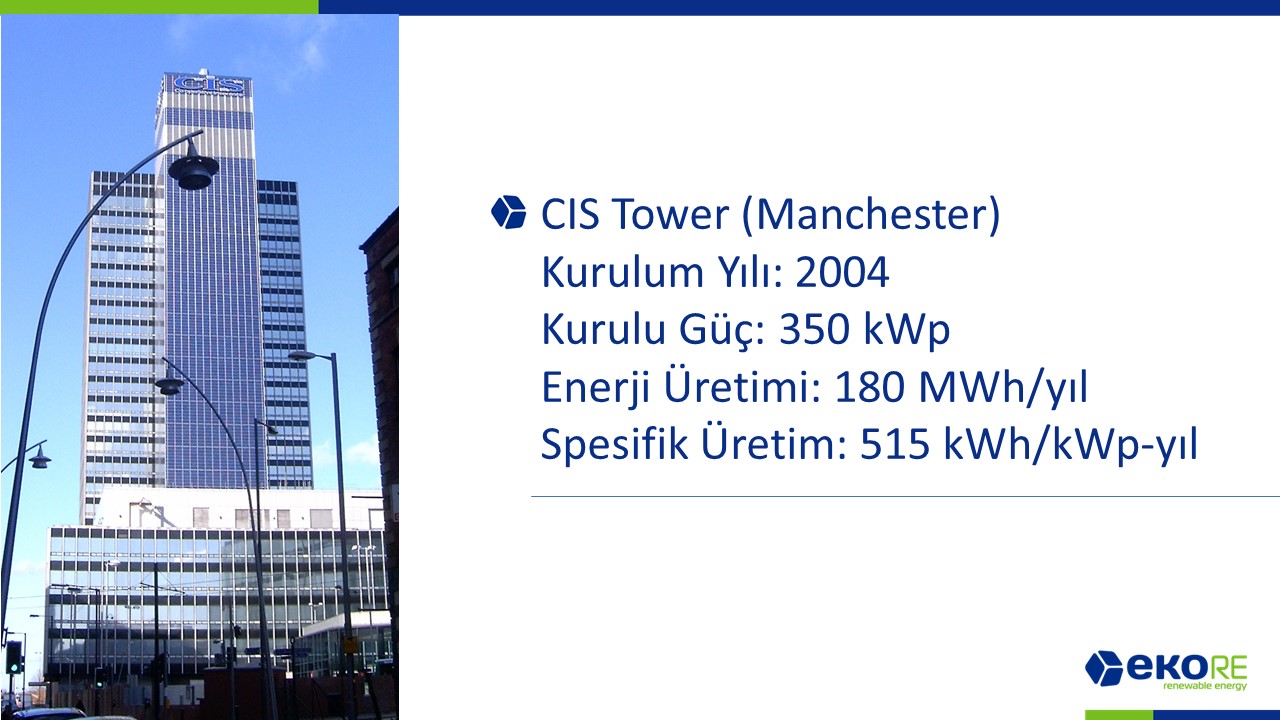
This is another application of crystal technology to the front.
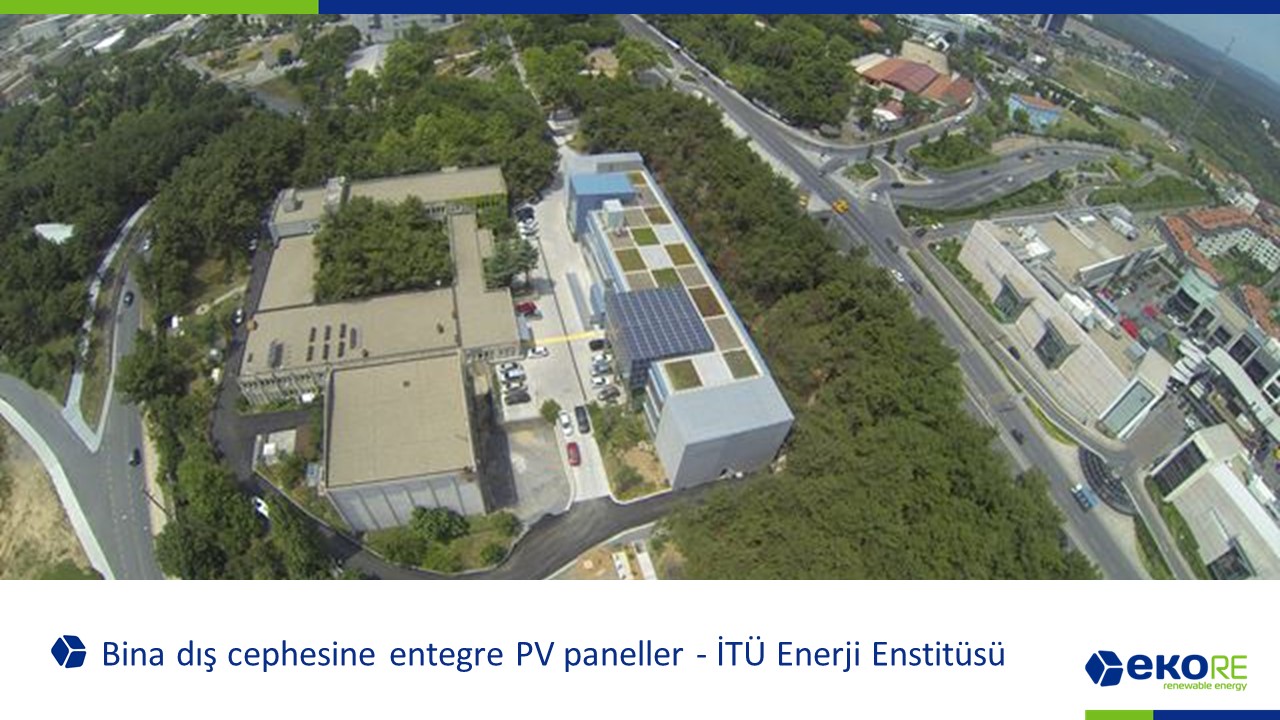
An example from Turkia. The roof and facade of ITU Energy Institute is covered with solar panels to generate electricity. Thus, some of the energy needs are met from solar energy.
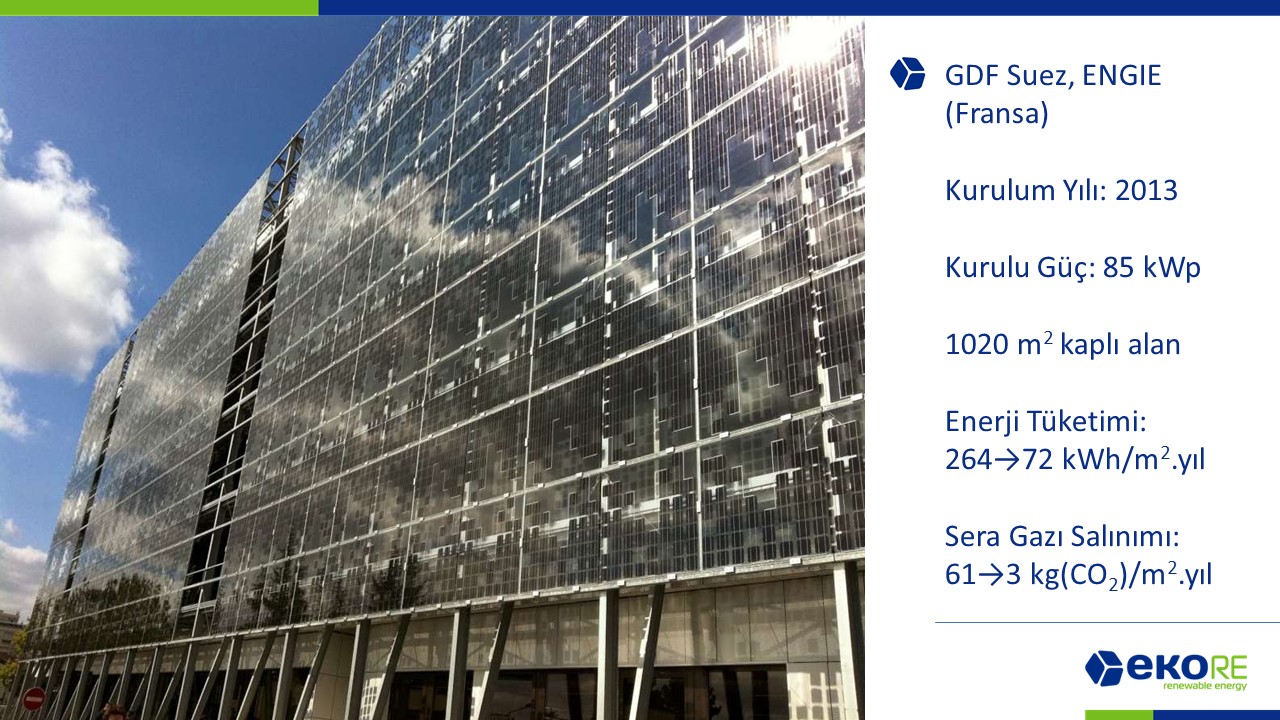
The world is increasingly turning to renewable energy sources. In the future, fossil fuels will only be used for raw materials. Among the renewable energy sources, solar energy technologies are the most promising in terms of abundance of applications. The world-renowned French natural gas company, whose former name stands for Gas de France, was influenced by the rapidly developing renewable energy flow, and it took the name gas, and adopted the name ENGIE, which sounded more sympathetic. In this example, we see the office building, which ENGIE has implemented with a functional and aesthetic design, using glass-to-glass monocrystalline cells.
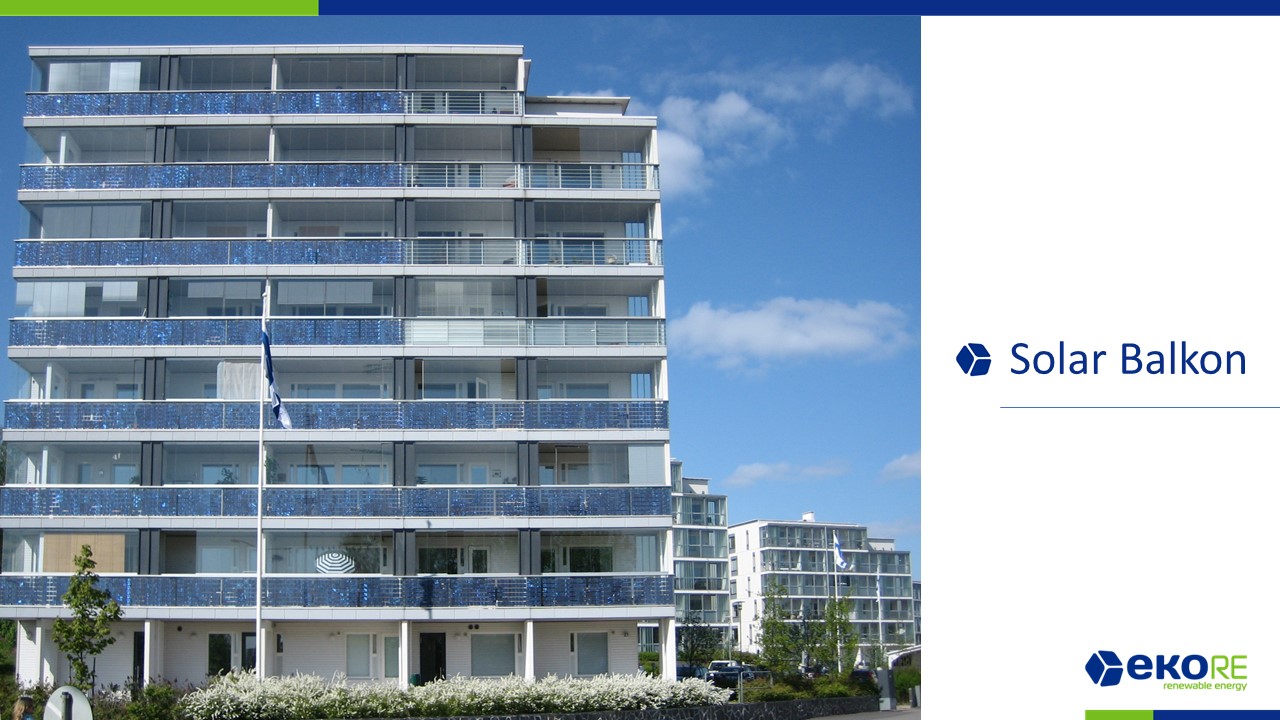
In this example, the glass-to-glass polycrystalline panels are integrated into the balcony moulding and an aesthetic look is obtained. Another innovative step towards zero energy consuming buildings.
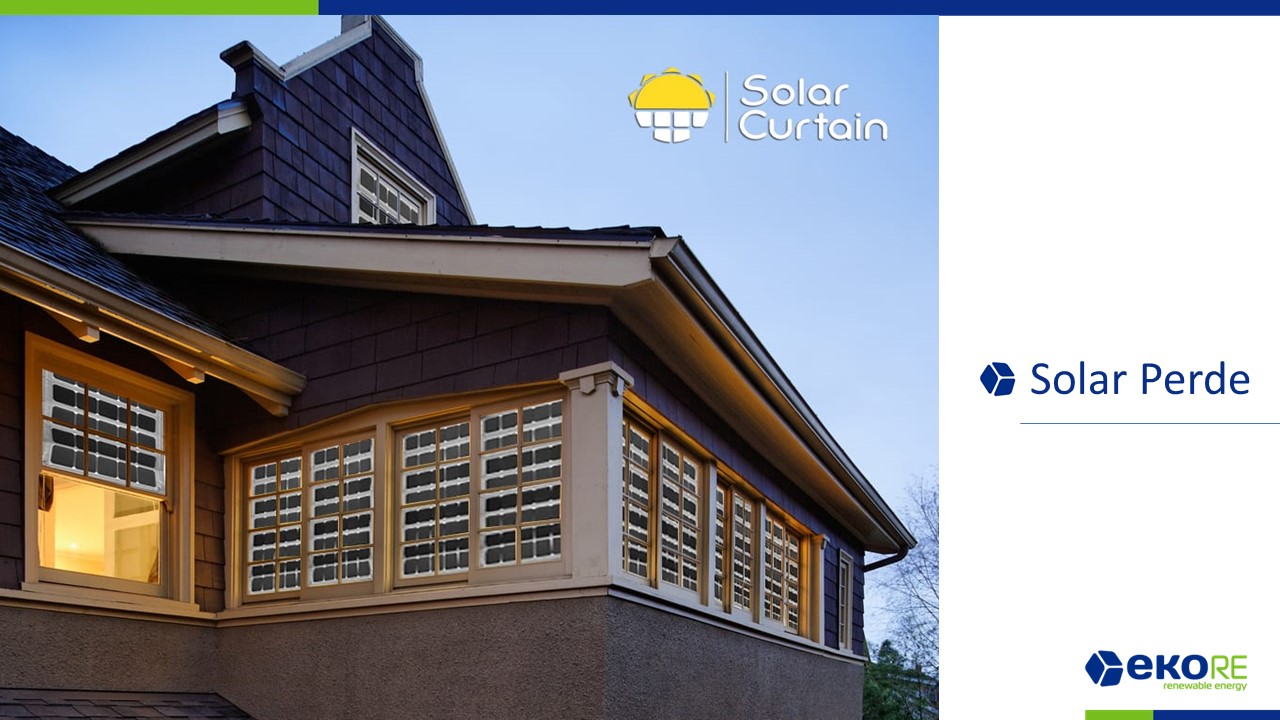
In solar curtains, which is a much simpler application, monocrystalline cells are sewn into the curtains, allowing you to generate electricity while protecting your home from the heat and the sun during the day.
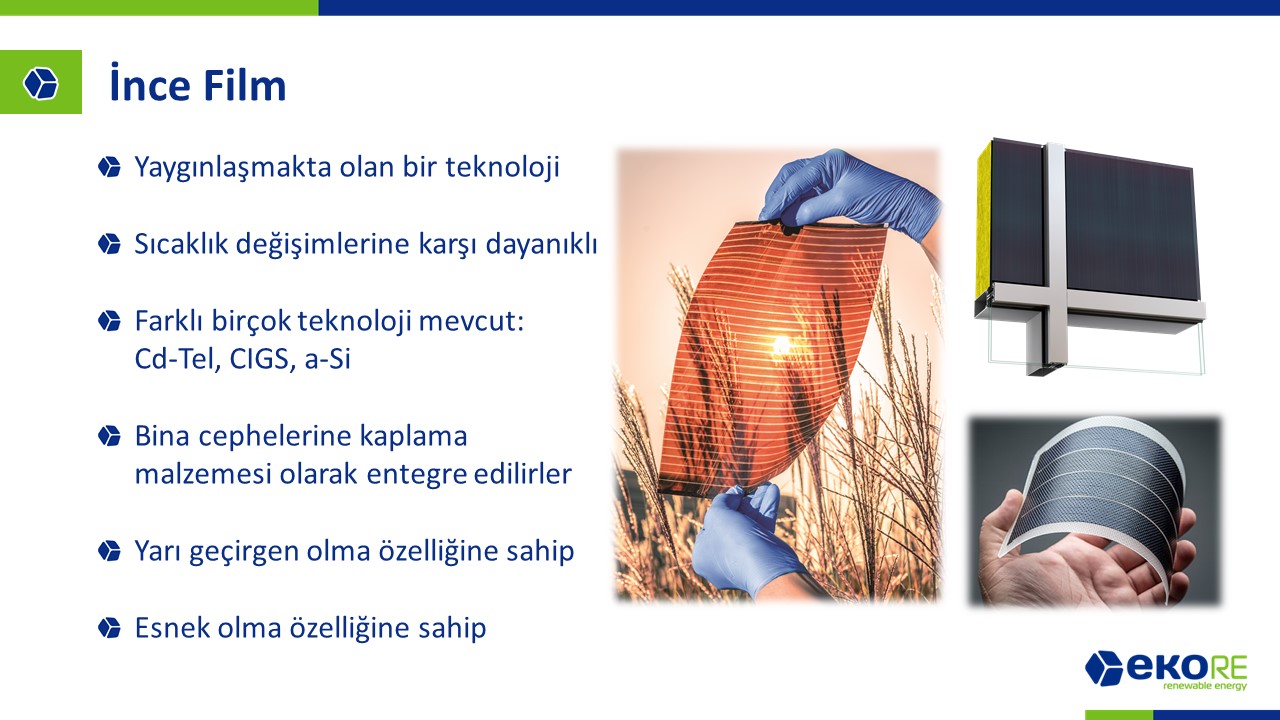
A developing technology. Although the price difference between crystal technology has increased more recently, this technology offers different advantages. The most important of these is that the temperature coefficient is much lower than the crystal panels. In other words, it suffers much less efficiency in hot weather than other technologies. Being semi-permeable and being able to produce bendable panels also provides many options in terms of application.
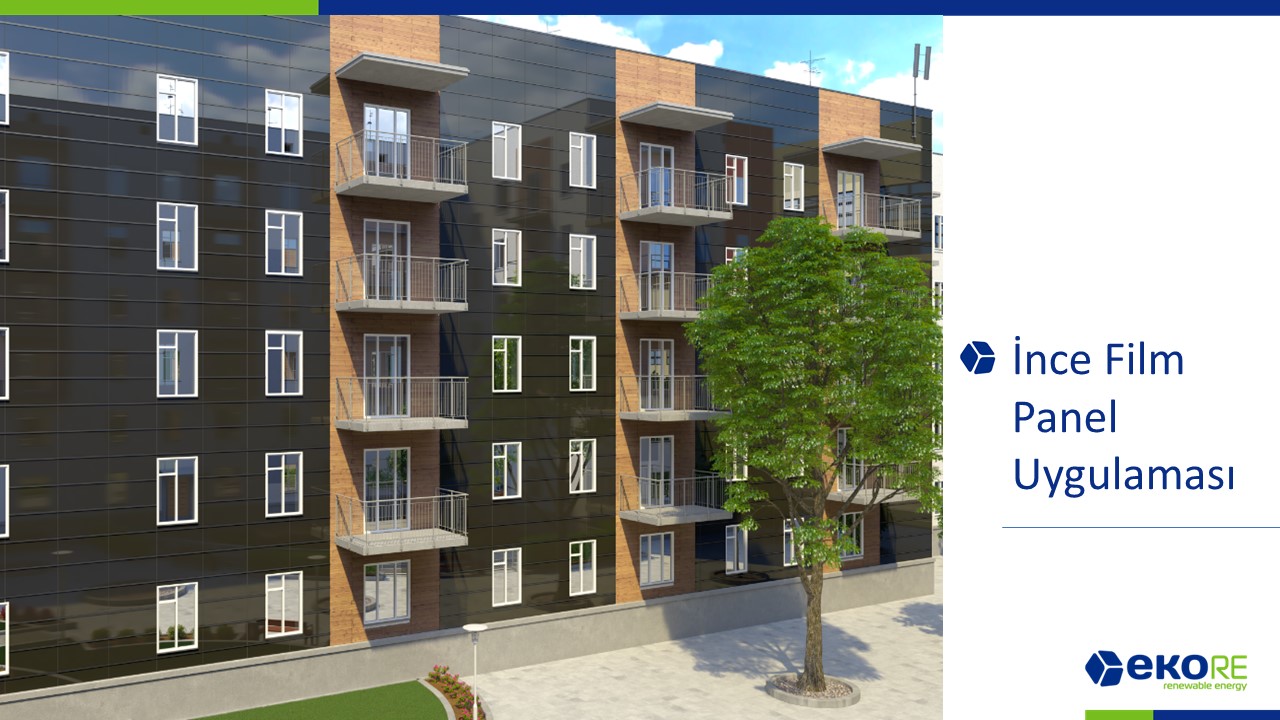
An aesthetic thin film facade application.
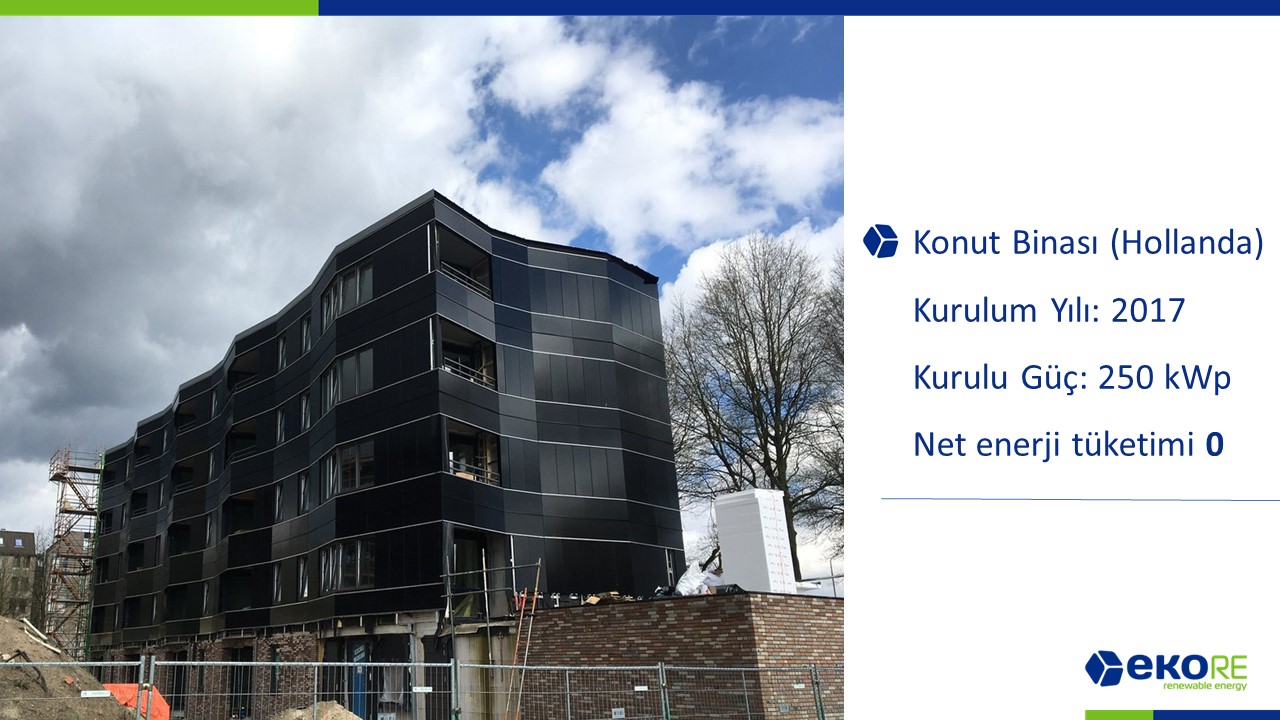
The three facades and roofs of the building are covered with panels. Thanks to heat pumps, the energy required for heating/cooling is supplied from the panels.
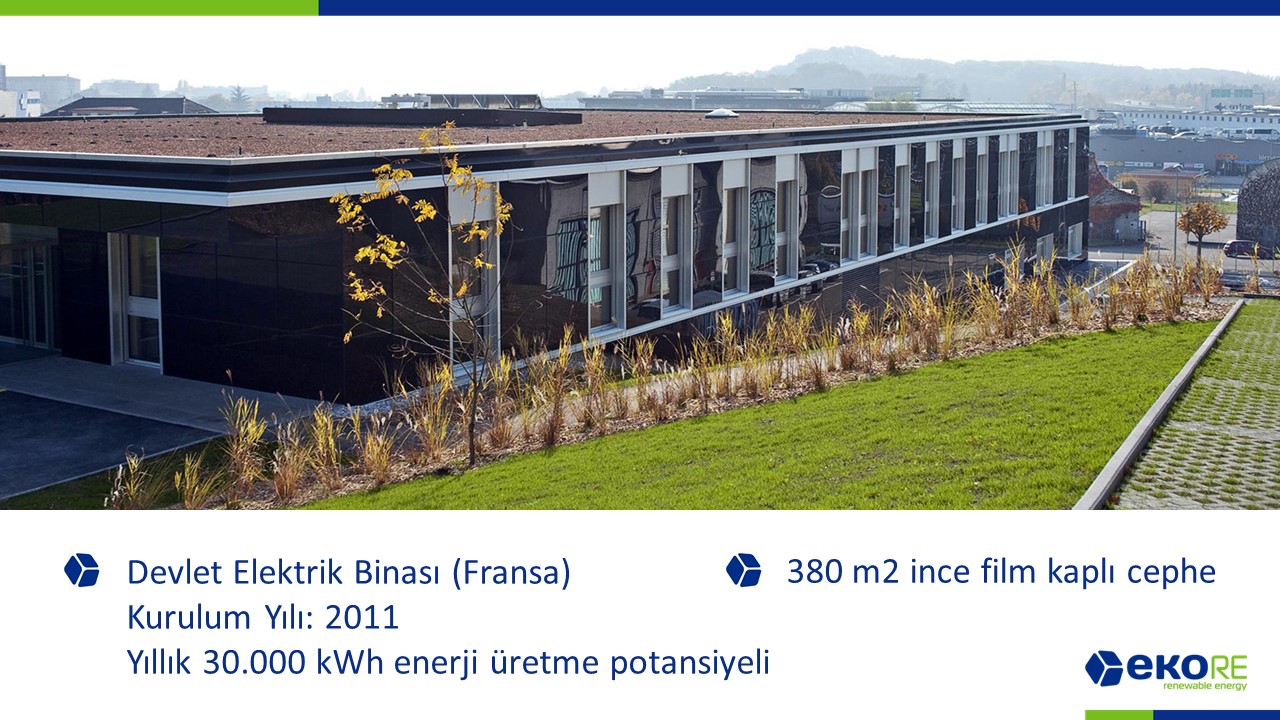
Another example of the use of thin-film panel technology on the facade, where it is almost impossible to distinguish between normal building facades.
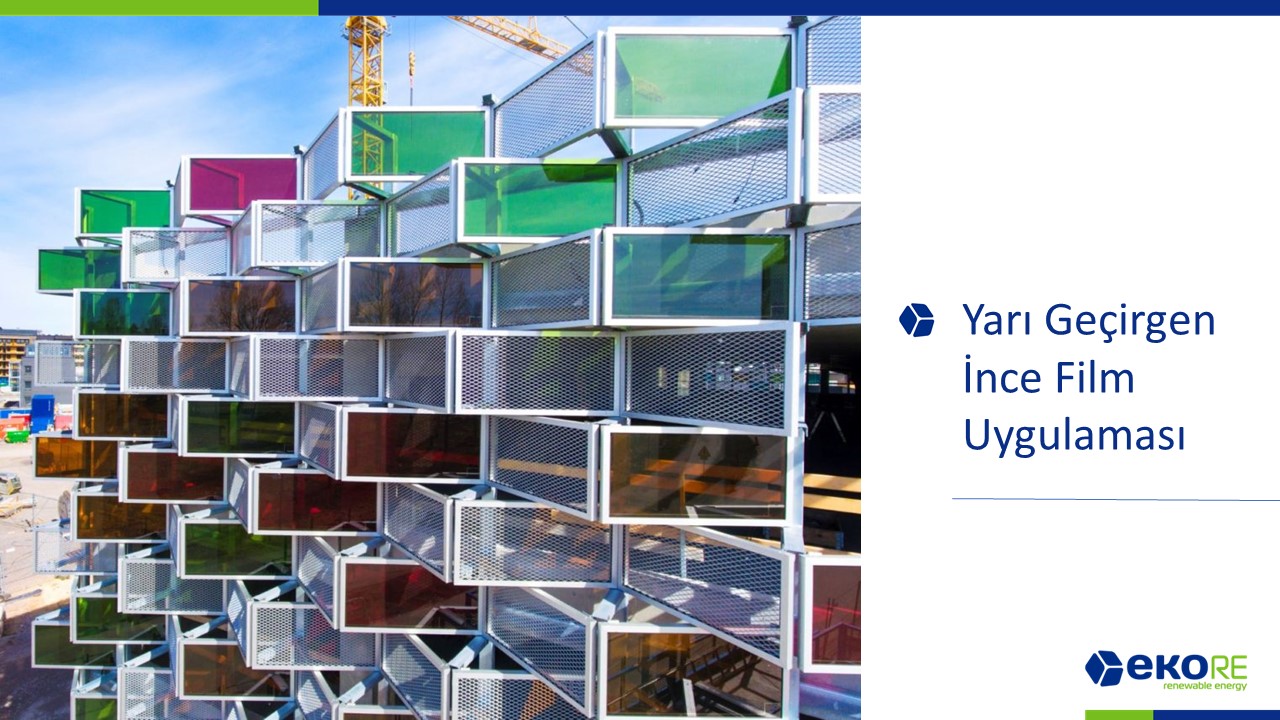
The glass-like surfaces in different colors are all actually solar panels. Another aesthetic design using semi-permeable thin film technology. Thanks to such projects, each building can be transformed into a power station and meet the electricity demand around the building.
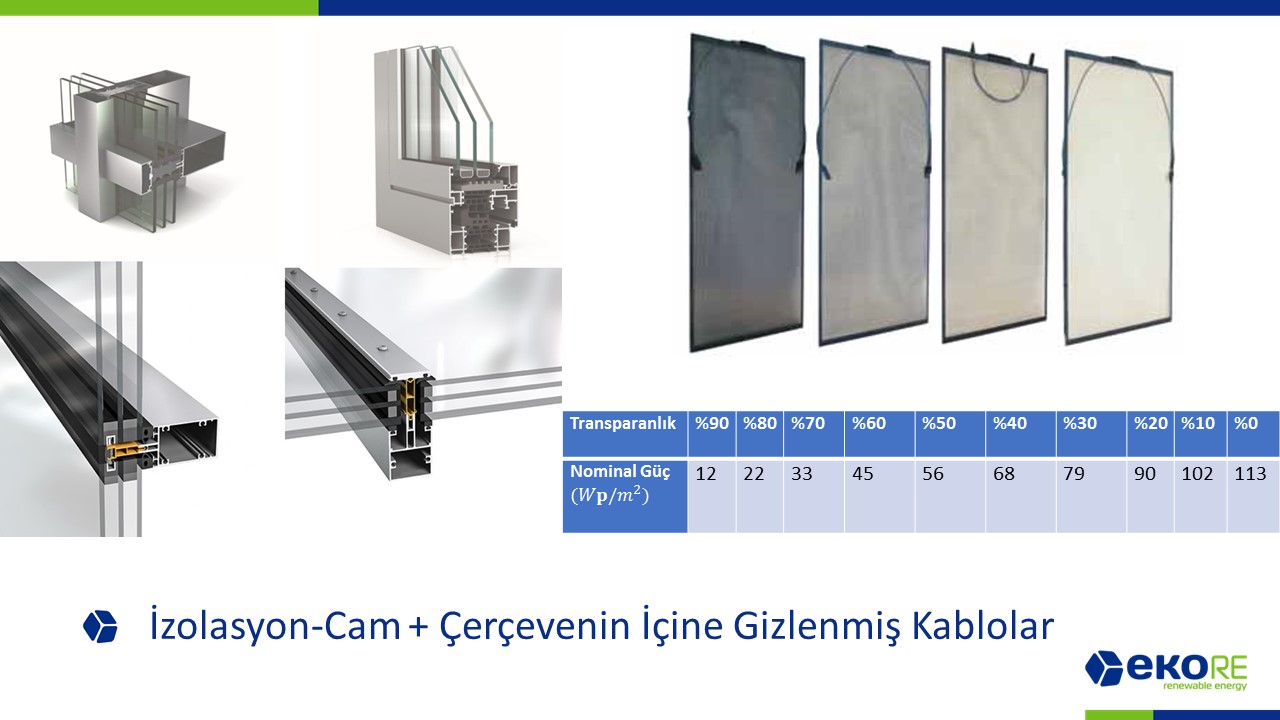
A technology that provides shade while generating solar energy. In this way it reduces cooling costs. Energy loss is minimal since insulated glass is used. Products with different levels of transmittance can be selected according to the application area. The design, which directs the produced electricity to the desired place thanks to the cables hidden inside the frame, is different from the standard glasses in terms of aesthetic appearance.
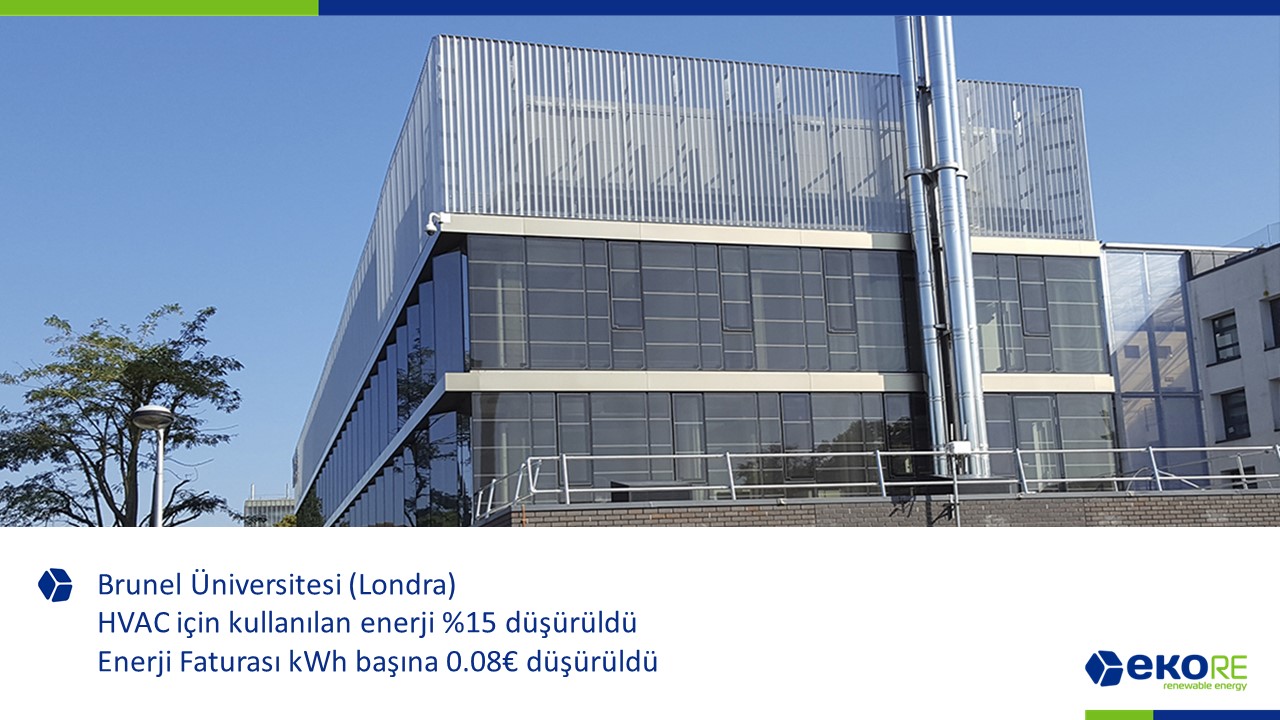 An example of semi-permeable thin film application.
An example of semi-permeable thin film application.
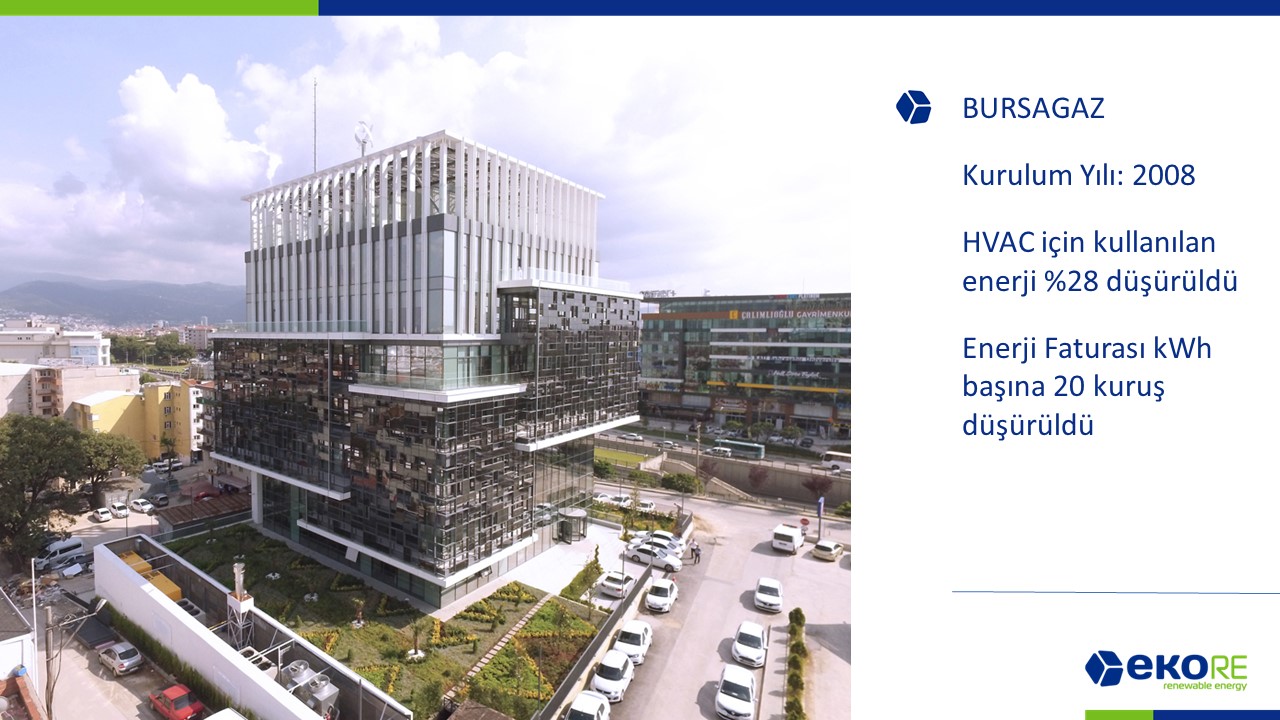
The Bursagaz black glass facade of the building, which is located in front of one of the best practices in Turkia is composed of semi-permeable panels. In the meantime, it was a nice coincidence that Tago Architecture, who was a speaker at this panel, made this application with me.
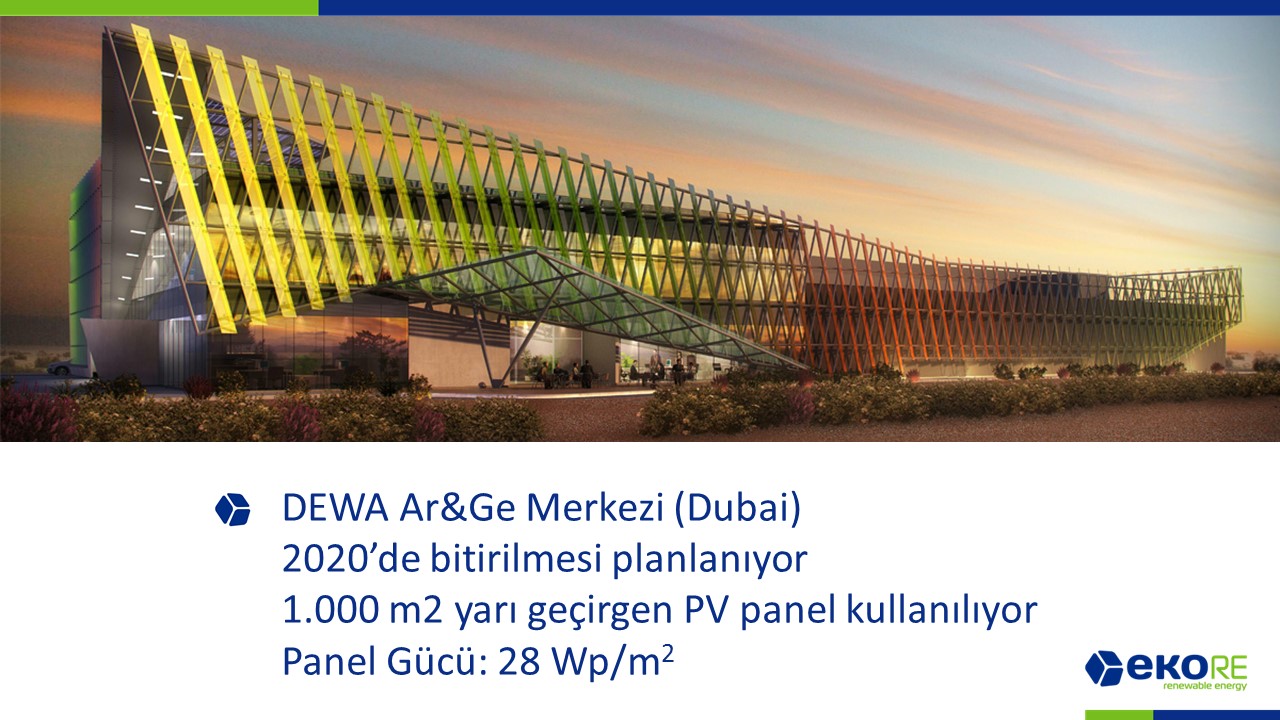
Semi-permeable PV fins in 6 different colors mounted on the exterior of the building are positioned at an angle of 31 degrees to achieve optimum sun angle.
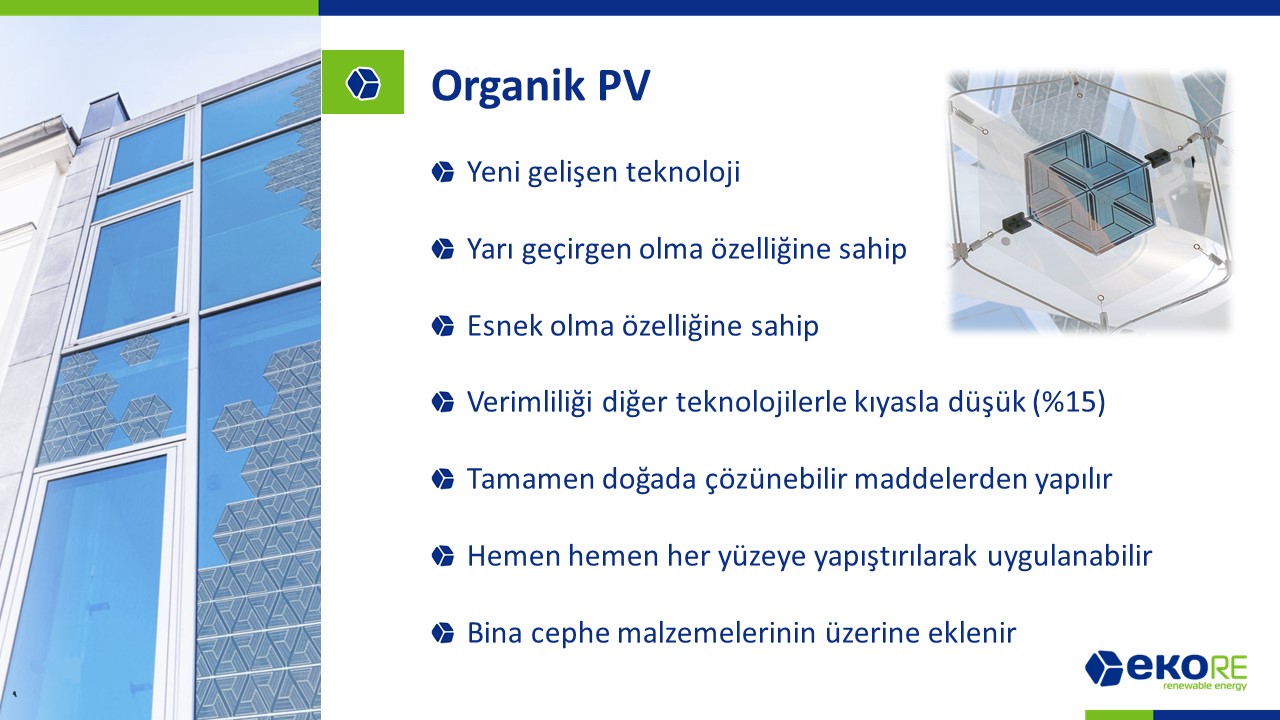
Although it is a newly developed technology and although its efficiency is lower than other technologies, the application variations of the panels made of organic materials on the facades are numerous. A technology that covers the loss of yield with its flexibility, semi-permeability, suitability for the circular economy and abundance of application. Since it is very light, it can be used for electricity production by sticking on almost all surfaces.
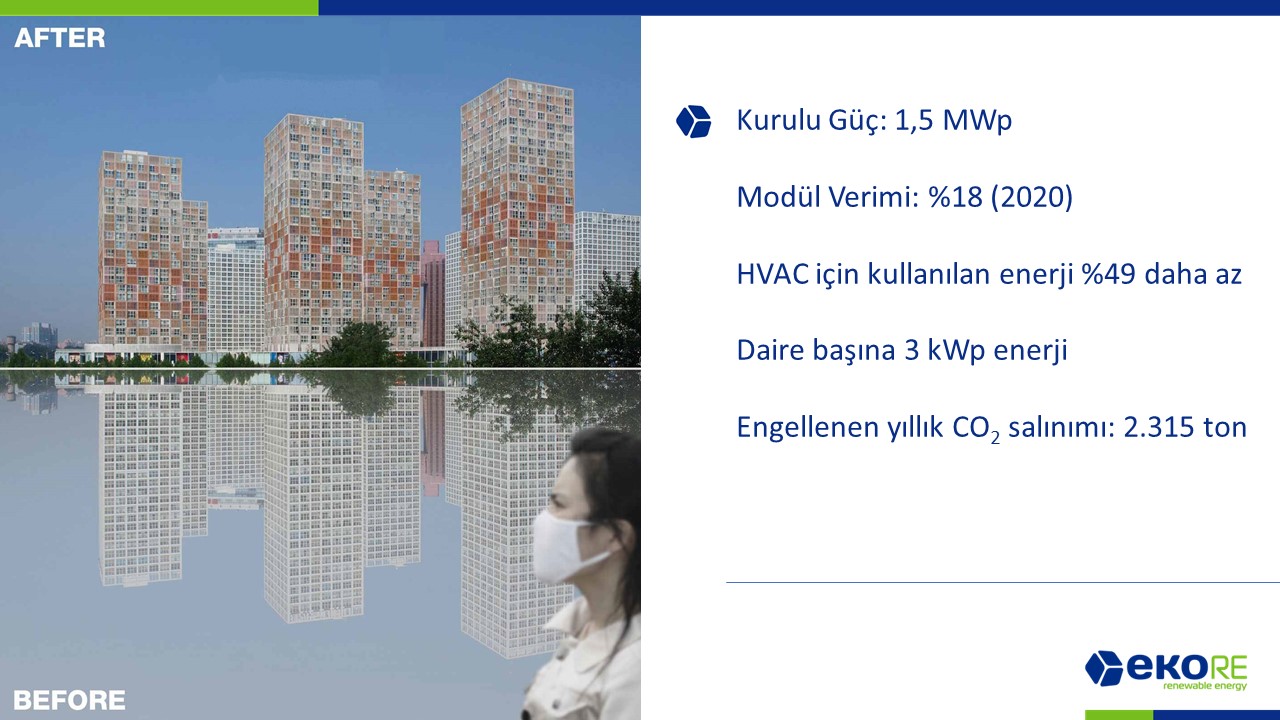
A building design covered with OPV (Organic PV)
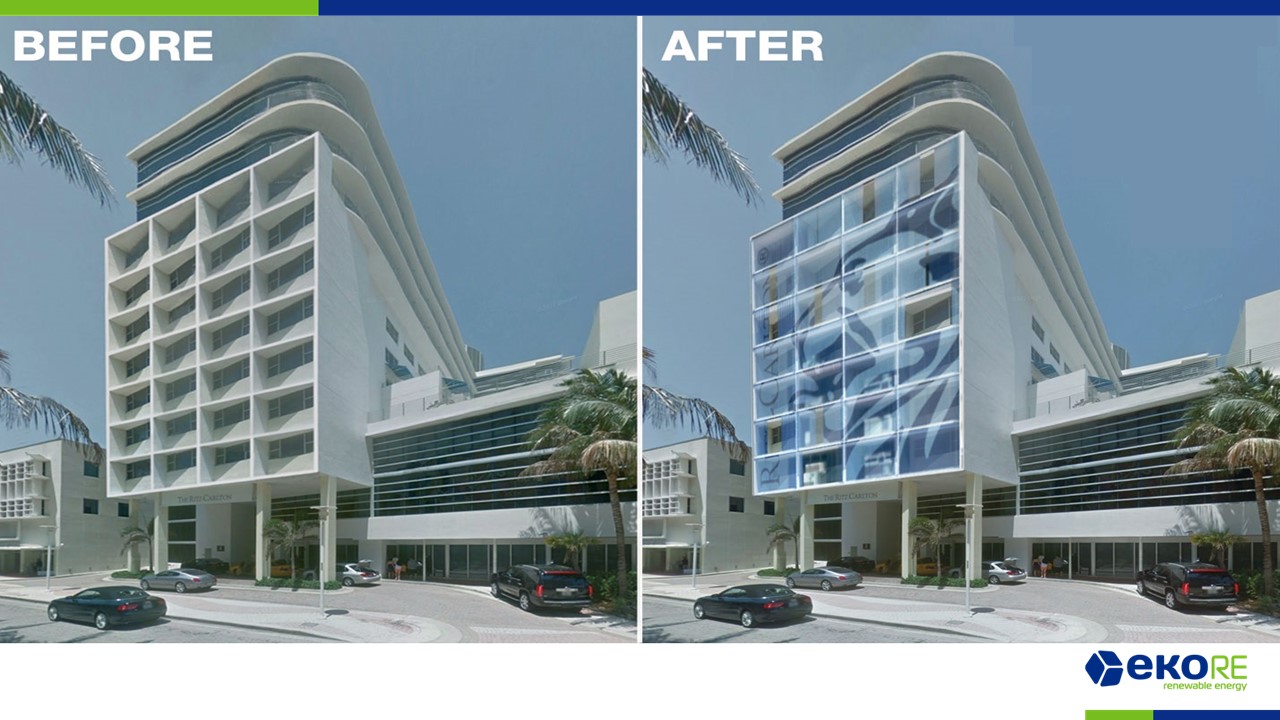
Organic PVs that can be designed specially which covered the facade of the Ritz-Carlton hotel in their own logos in this example (it is conceptual sampling, not real practice). Thanks to its specially designed feature, OPV manufacturers and architects should work in cooperation in the buildings of the future. Thus, it will be able to place the desired visual on the surface of the building.
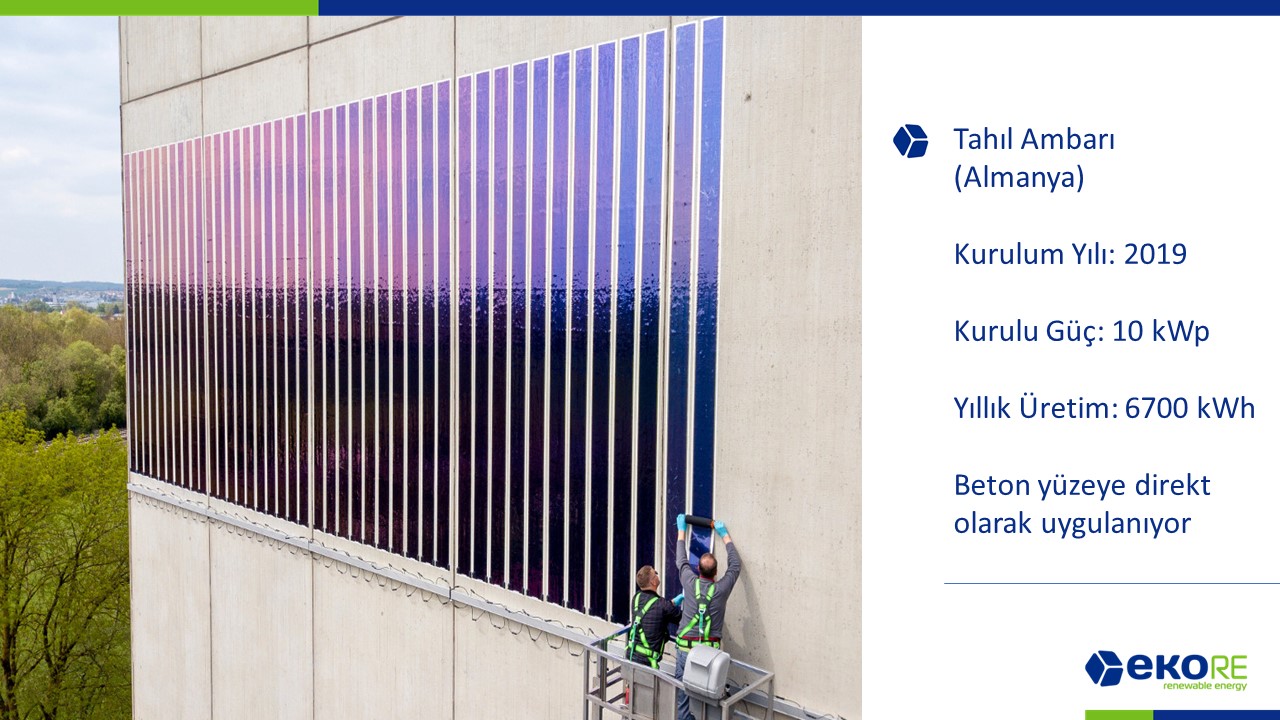
An example from Germany which shows a numerous amount of OPV technology adhered to the blank facades which can be easily applied.
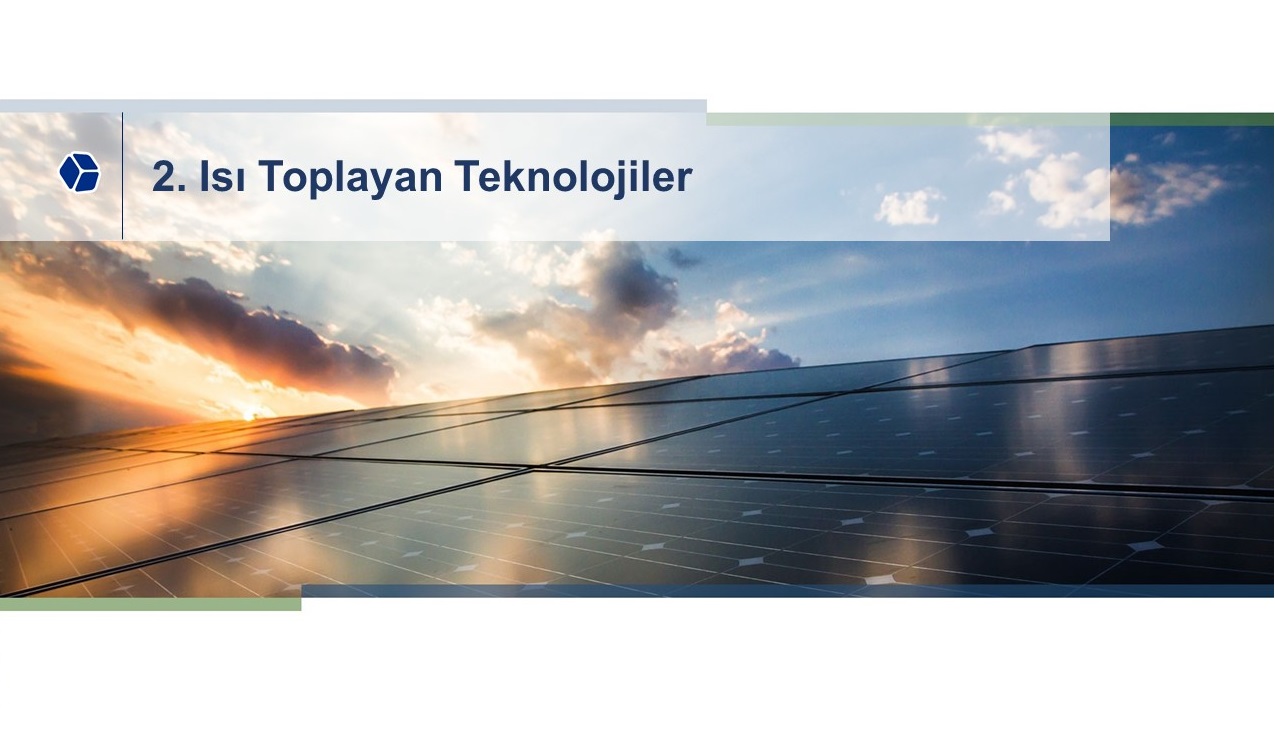 Now let's come to the heat. Another important energy source such as electricity is heat. You can use heat in air conditioning and water heating. It is not my specialty, but I would like to give you some examples.
Now let's come to the heat. Another important energy source such as electricity is heat. You can use heat in air conditioning and water heating. It is not my specialty, but I would like to give you some examples.
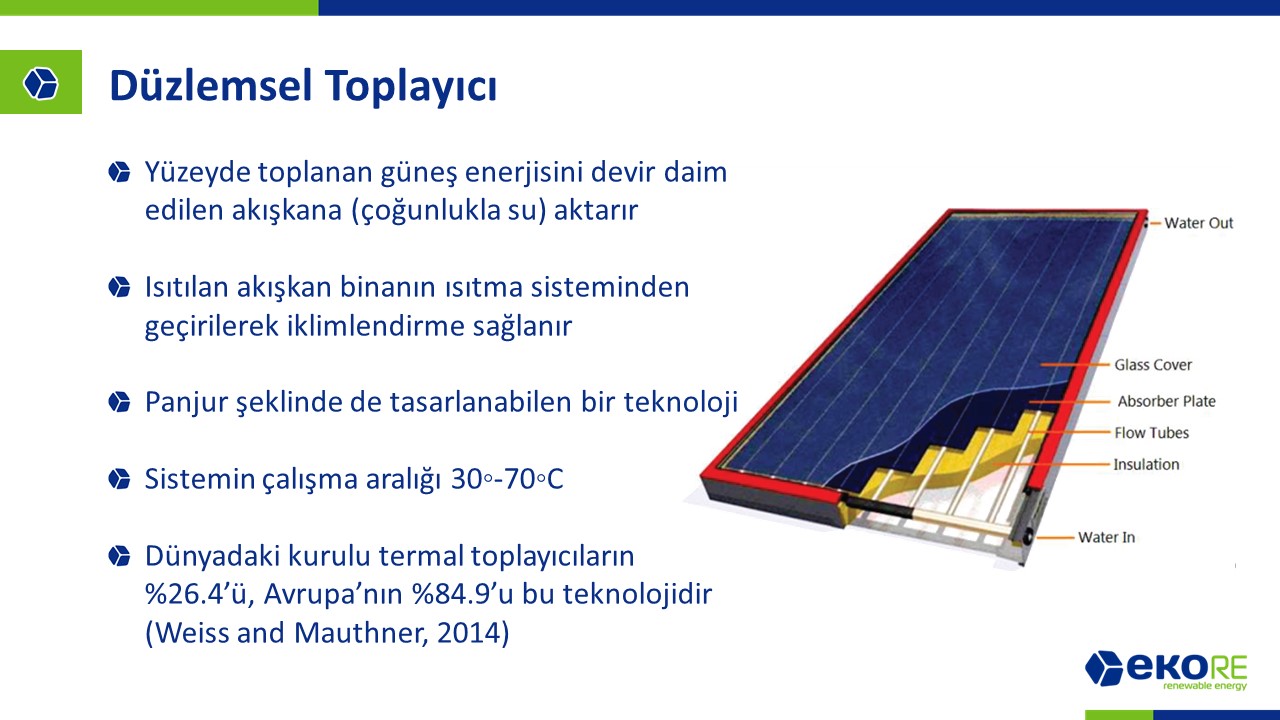 The most basic technology of water heater technologies is the planar collector. This is the most preferred in Turkia, especially water heater models in our southern regions. It is quite common in the country.
The most basic technology of water heater technologies is the planar collector. This is the most preferred in Turkia, especially water heater models in our southern regions. It is quite common in the country.
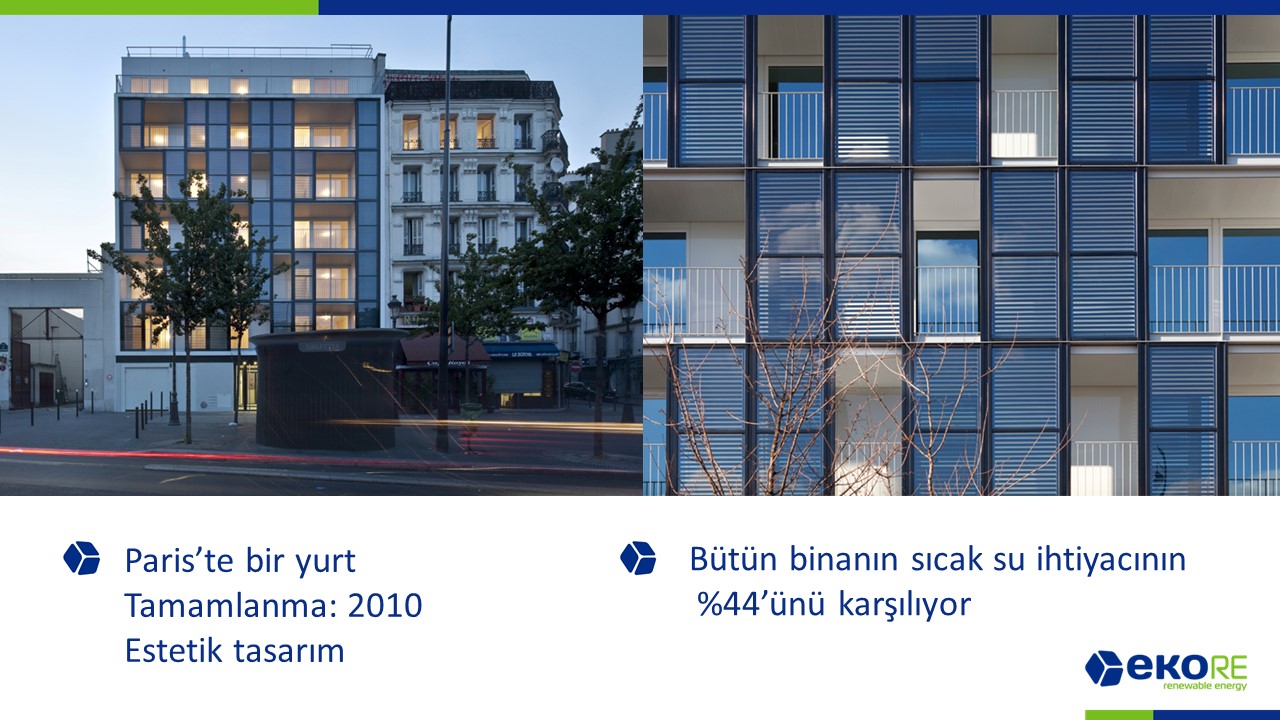
Here's an interesting design made with a planar collector. Such front water heating is better than nothing. It's not bad aesthetically.
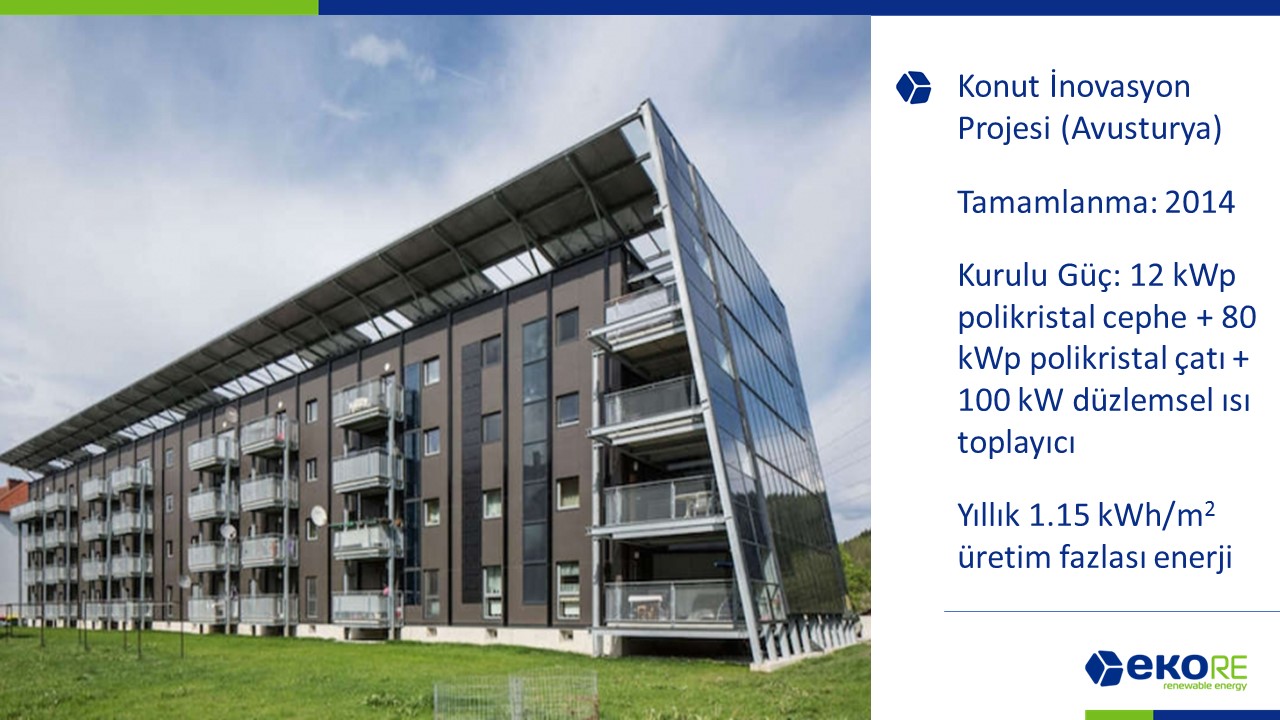
There are two types of main facade applications. The first one is applied to new buildings, the other is applied to existing buildings. This building belongs to the second category. A housing project implemented by PlusEnergy for houses built after World War II (1950-1980). The operational cost of the building was very high, as it was made using the prefabricated concrete sandwich method, it did not have insulation and ventilation, and was heated by coal. Thanks to the integration of the panels added to the upper part and only one facade, the energy consumed by the building is not only reduced to negative but also has an aesthetic appearance.
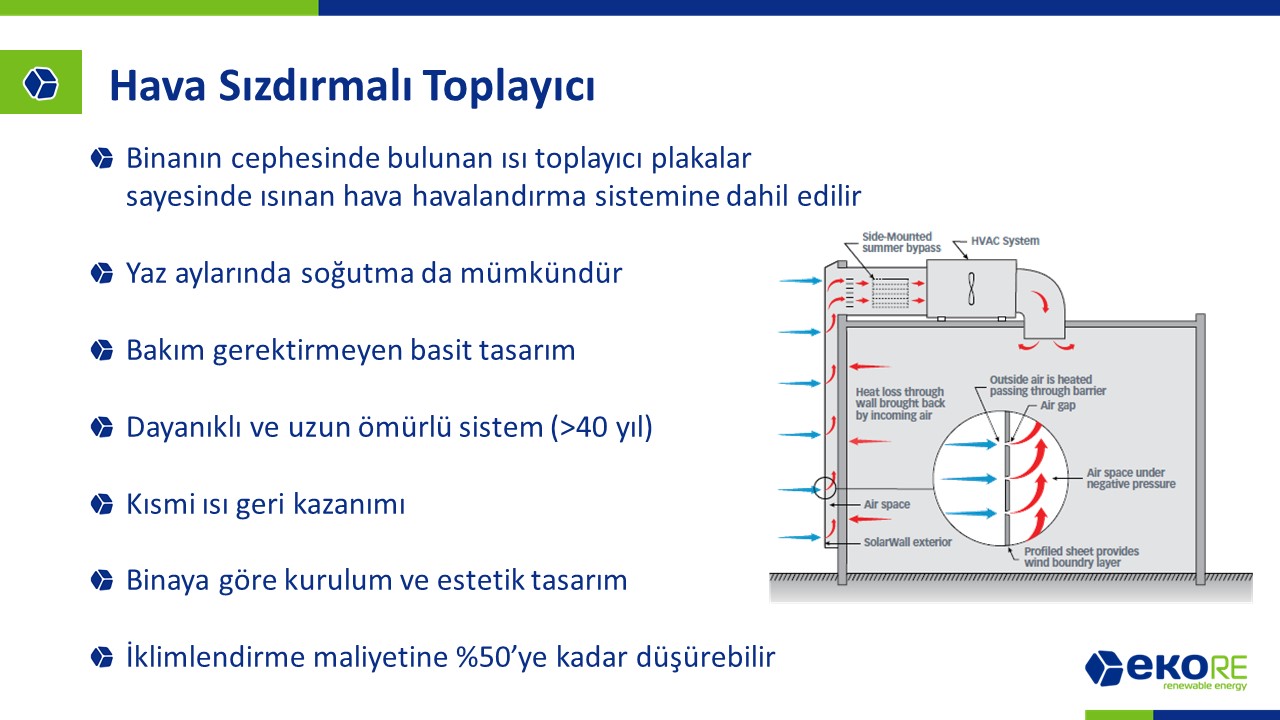
Airtight collector systems are also among invisible heroes. It provides serious energy efficiency in buildings as a function and is stylish in design.
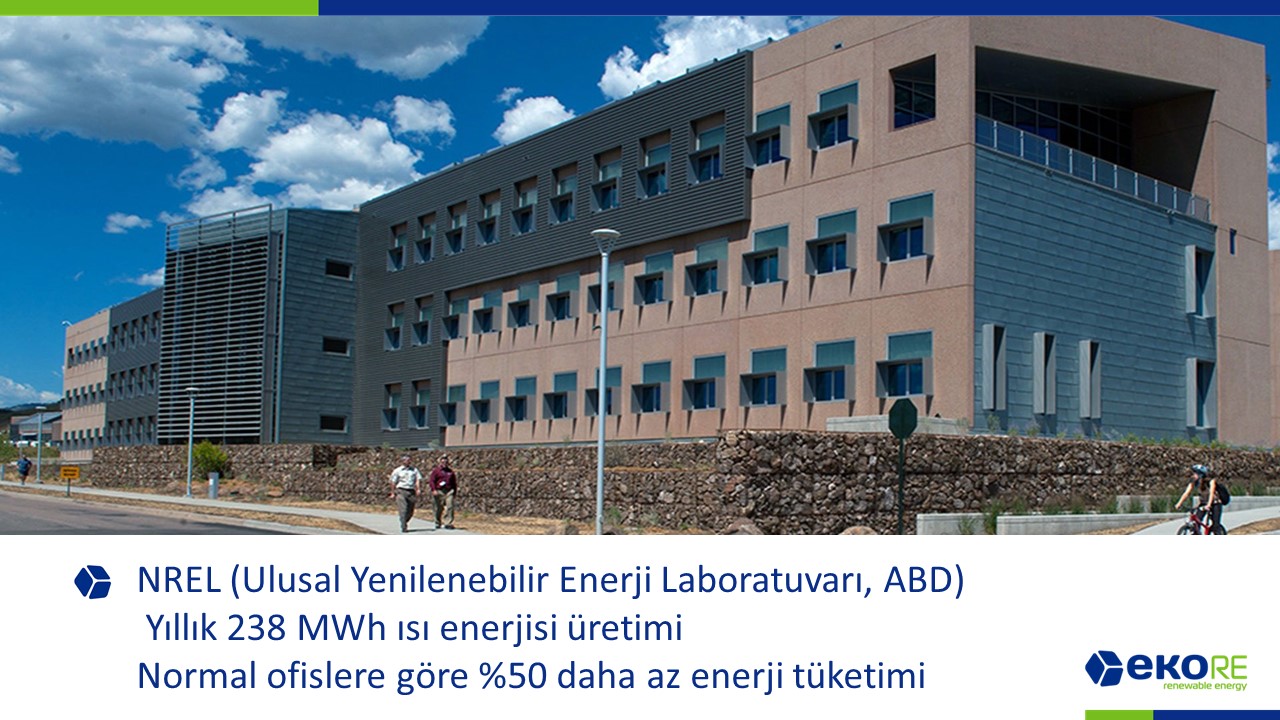
With this application, which has a modern appearance, the energy consumption of the offices was reduced by 50% and used as both a heating and cooling system.
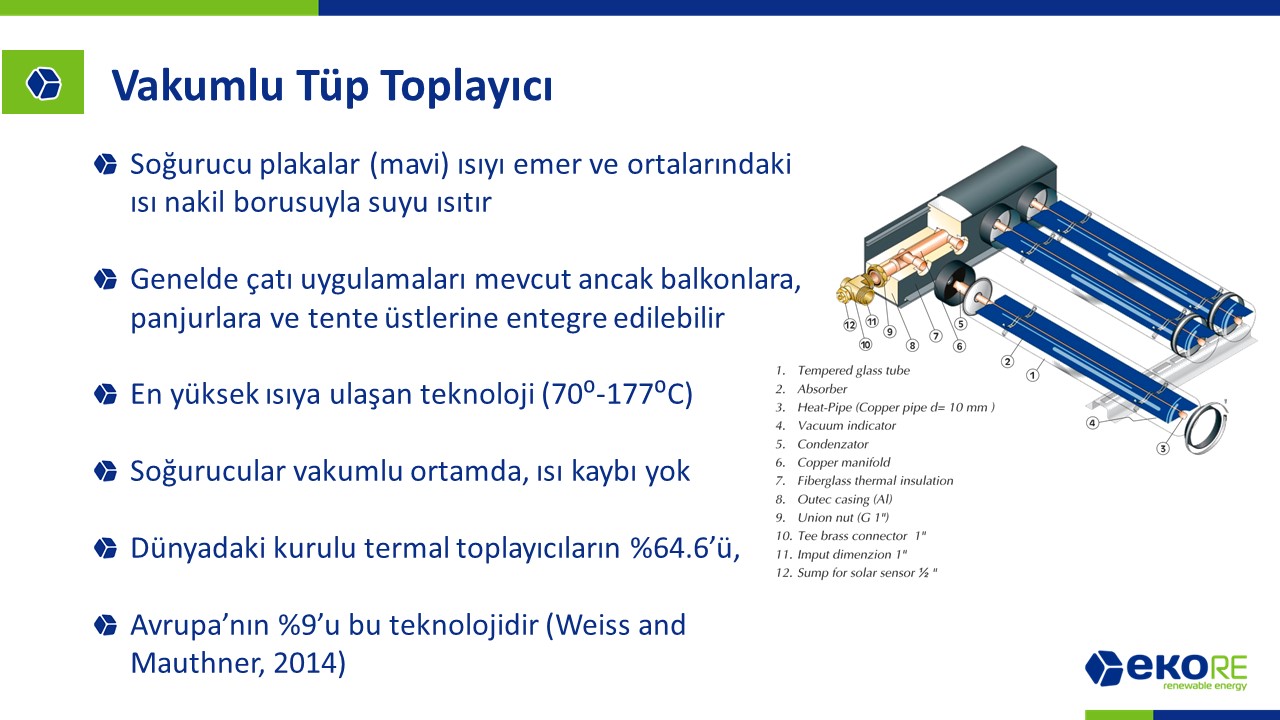 Solar water heaters were the first ones to enter our lives in Turkia. As an advanced model of the planar collector from water heaters, we can count the vacuum tube collectors. Since vacuum is used here, higher temperatures can be achieved for a longer time. Although the facade application of this technology, which is mostly located in the south and on the roofs of summer houses, is not common, there are possibilities of use. It is a highly efficient system since it is the technology that rises to the highest temperature among the technologies that collect heat. To achieve this high efficiency, heat absorbing plates are integrated into vacuumed tubes to minimize heat loss. It looks very stylish. Better than nothing.
Solar water heaters were the first ones to enter our lives in Turkia. As an advanced model of the planar collector from water heaters, we can count the vacuum tube collectors. Since vacuum is used here, higher temperatures can be achieved for a longer time. Although the facade application of this technology, which is mostly located in the south and on the roofs of summer houses, is not common, there are possibilities of use. It is a highly efficient system since it is the technology that rises to the highest temperature among the technologies that collect heat. To achieve this high efficiency, heat absorbing plates are integrated into vacuumed tubes to minimize heat loss. It looks very stylish. Better than nothing.
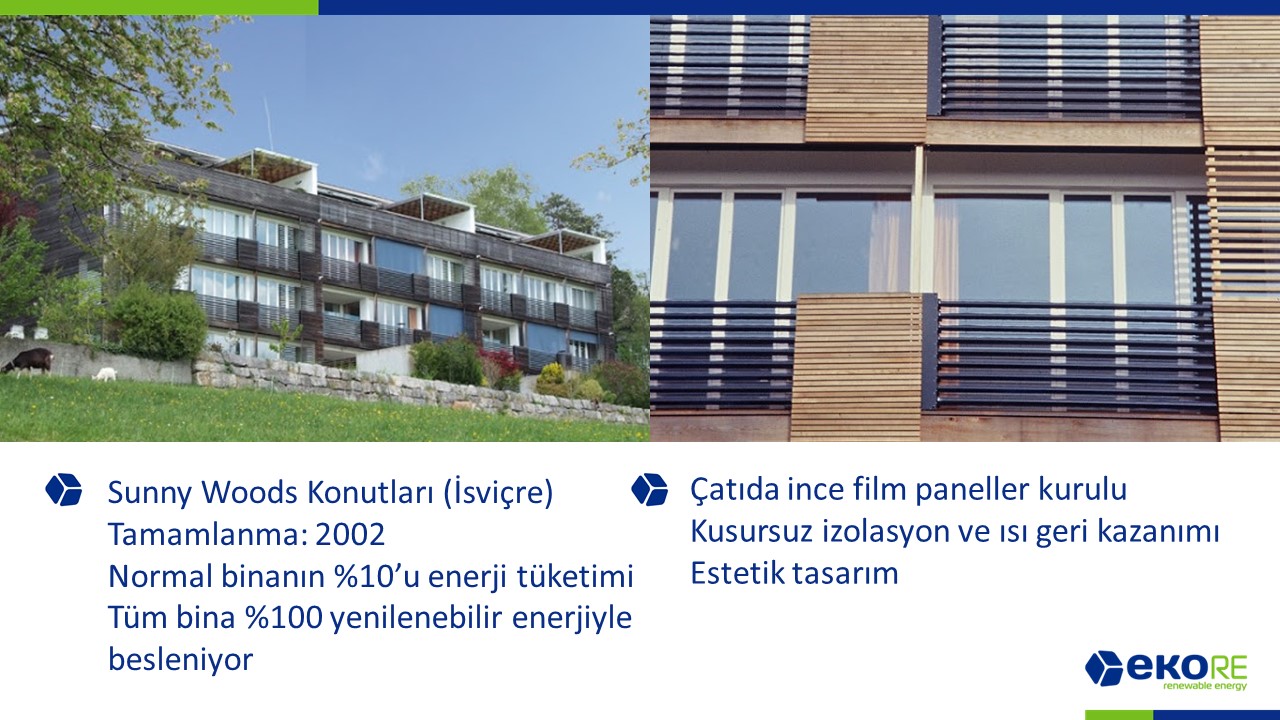
As seen in this example in Switzerland, it is possible to design balcony railings using this technology. In this design, which also looks aesthetic and stylish, all the hot water need of the building is provided by vacuum tube collectors.
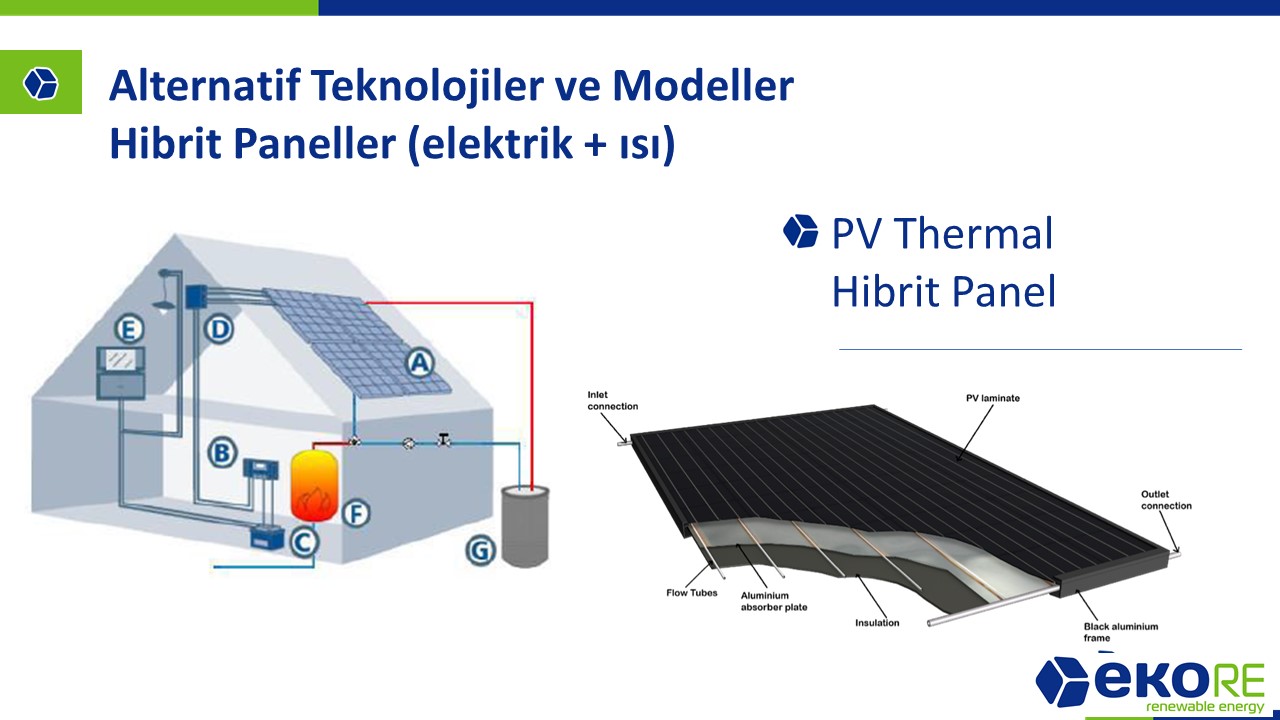 The cells on the front of the hybrid panels produce electricity from sunlight, while the absorbers on the back use the heat energy that falls on the panel to heat the water. In this way, while producing electricity to be used in the building, the need for hot water is also met. We, as EkoRE, want to produce a “Hybrid Panel” in the future.
The cells on the front of the hybrid panels produce electricity from sunlight, while the absorbers on the back use the heat energy that falls on the panel to heat the water. In this way, while producing electricity to be used in the building, the need for hot water is also met. We, as EkoRE, want to produce a “Hybrid Panel” in the future.
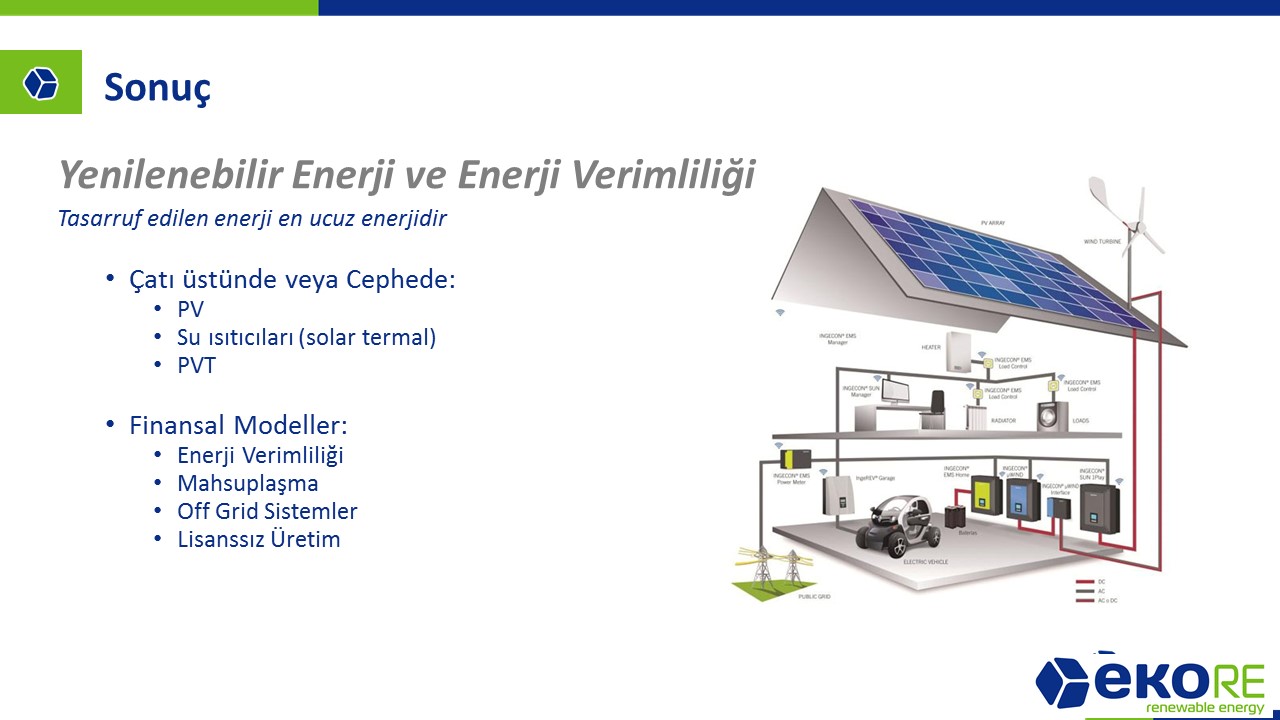
As a result, although there are so many different technologies, the most useful and cheapest energy is the energy saved. Therefore, it is imperative that people change their consumption culture in a way that is more economical than just using technology. As a result, there are 3 main technologies used in the facades; Electric generating PV panels, heat collecting technologies and hybrid panels. If we summarize the advantages of these systems financially, firstly, it decreases the energy bills by increasing the energy efficiency of the buildings. With the emerging offsetting application, the electricity produced in the middle of the day when the demand is low feeds the grid and significantly reduces the total energy consumed. In cases where the network cannot be connected, the network is insecure or it is not desired to be affected by power cuts, it is also possible to install a completely network independent system supported by batteries. Finally, especially solar energy systems installed in the industry can benefit from the unlicensed electricity regulation and feed extra energy back into the grid and earn extra income.
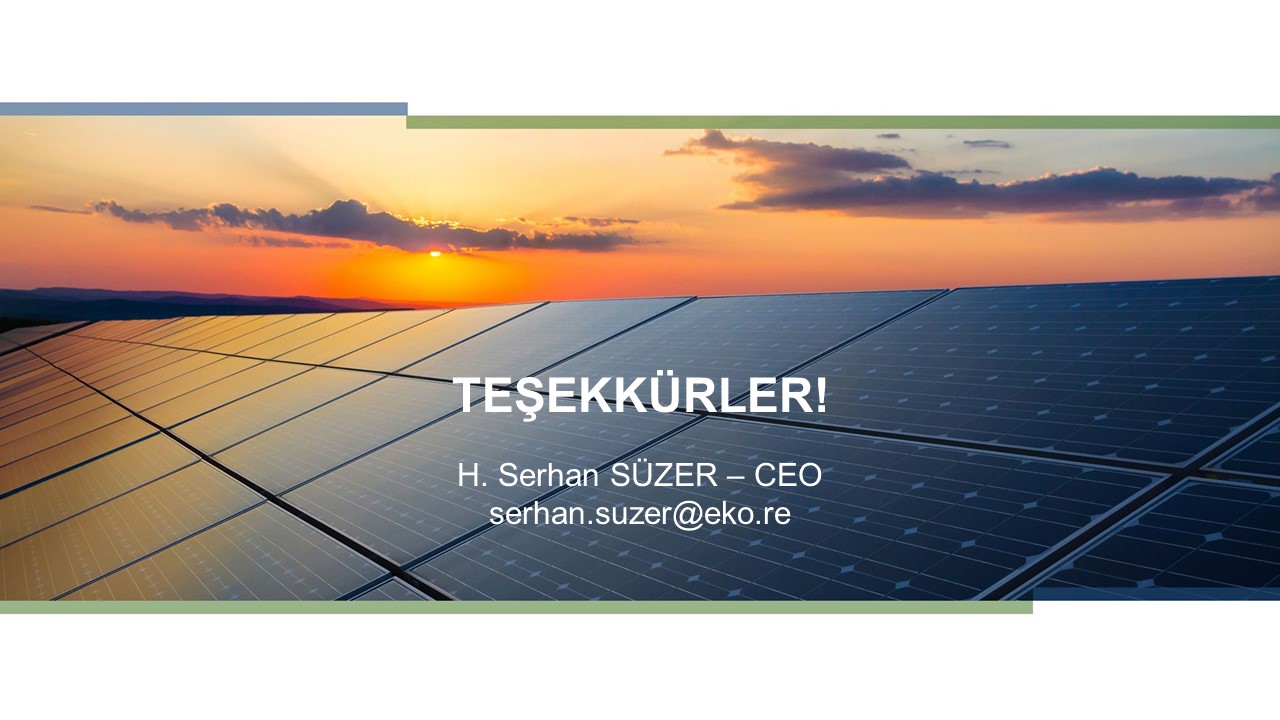
A surprising timing and prominent highlights
In explaining all this, I had a 'timer' in front of me. I started talking exactly 21 minutes before and ended my speech with 1-minute remaining. I could not believe that I was so punctual. Just in time, I handed the word over to the moderator. The moderator also made his last comments and finished the panel.
I would like to bring this to an end by transferring the sentences I underlined in my presentation here:
- In the future, everything will happen with distributed system logic. In other words, there will be on-site production and on-site consumption. Distributed system model will be applied in life-critical needs such as energy, water and food.
- We need to act with the logic of producing energy, water and food on all fronts and roofs.
- In order to continuously increase production in the limited area, “productivity increase” will be one of the two most important topics of R&D. The second important issue is the decrease in costs. Cost reduction is important to make solar energy available to all people.
- For me, function is more important than aesthetics. However, of course, it is best to use both functional and aesthetic products in our work. Finally, I would like to share the videos of certain parts of my speech:
The speech I made at the beginning
The Nigde BOR situation in our country
Wrapping up my speech
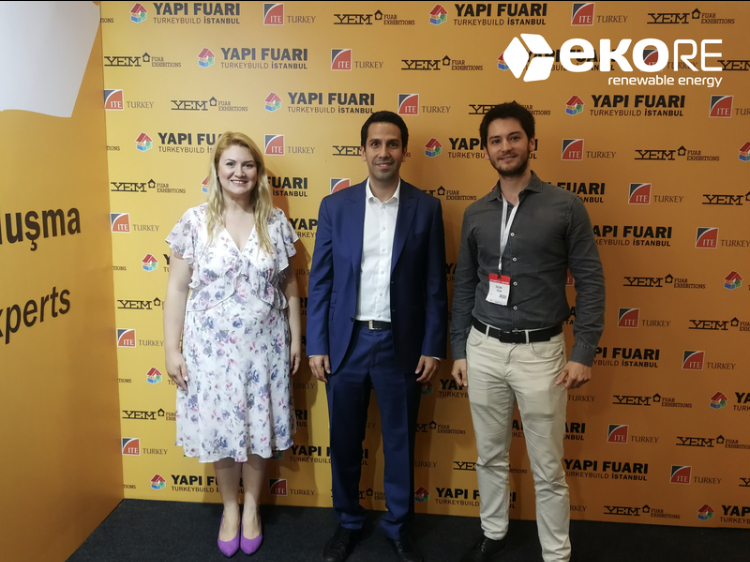
The photo we took with the EkoRE team accompanying me after my speech was over…
Tag: iş dünyası


